Paul van Yperen's Blog, page 400
November 16, 2014
Nadja Regin
Serbian actress Nadja Regin (1931) started her career in Yugoslav-German co-productions and later she worked in Germany, Austria and New Zealand. In England, she guest-starred in many classic TV series of the 1960s and she appeared opposite Sean Connery in two James Bond films.
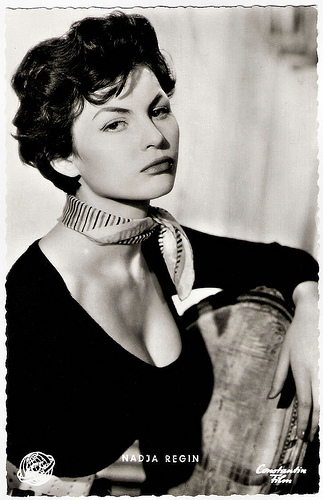
German postcard by Kunst und Bild, Berlin-Charlottenburg, no. I 240. Photo: A. Grimm / CCC / Constantin. Publicity stll for Die Unschuld vom Lande/The babe in the woods (Rudolf Schündler, 1957).
The Man without a Body
Nadja Regin was born as Nadezda Poderegin in Niš, Serbia in 1931. She graduated from the Academy of Dramatic Arts in Belgrade and also the University of Belgrade's Faculty of Philosophy.
Her acting career began during her student years with small parts in Yugoslavian films like Prica o fabrici/The Factory Story (Vladimir Pogacic, 1949). She also appeared in the first film ever made in Macedonia, Frosina (Vojislav Nanovic, 1952) with Meri Boskova.
Her career expanded through such Yugoslav-German co-productions as Das Haus an der Küste/The House on the Coast (Bosko Kosanovic, 1954) with René Deltgen , to Germany.
There she played supporting parts in films like the drama Roman eines Frauenarztes/Novel of a woman doctor (Falk Harnack, 1954) with Rudolf Prack , and the romance Auf Wiedersehen, Franziska!/Goodbye, Franziska (Wolfgang Liebeneiner, 1957) starring Ruth Leuwerik and Carlos Thompson .
Later, she moved to England, where she appeared in the horror film The Man without a Body (Charles Saunders, W. Lee Wilder, 1957). A scientist resuscitates the head of 16th-century seer Nostradamus by transplanting it onto the body of a man suffering from a brain tumour. He does it for the benefit of an avaricious financier who wants the prophet to give him the power of prediction in business...
In Don't Panic Chaps! (George Pollock, 1959), a British comedy set in WW II, she played an attractive young woman who set some forgotten soldiers on an Adriatic island back into a competitive, hostile attitude.
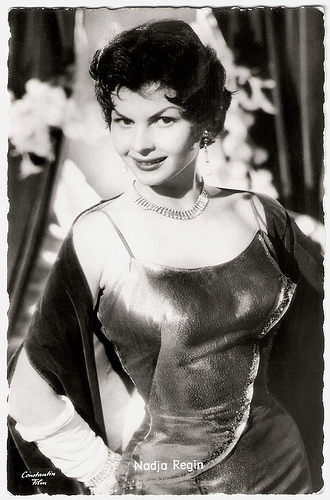
German postcard by Kolibri-Verlag, Minden/Westf., no. 2588. Photo: A. Grimm / CCC / Constantin. Publicity stll for Die Unschuld vom Lande/The babe in the woods (Rudolf Schündler, 1957).
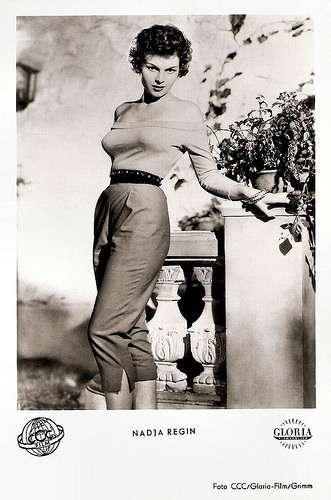
German postcard by Kunst und Bild, Berlin, no. A 1262. Photo: A. Grimm / CCC / Gloria.
Two James Bond films
Nadja Regin played the female lead in the thriller The Fur Collar (Lawrence Huntington, 1962) about an espionage ring.
She then acted in two James Bond films featuring Sean Connery . In the second James Bond film, From Russia with Love (Terence Young, 1963), she was the lonely mistress of Kerim Bey (Pedro Armendáriz).
She also appeared in a smaller but still notable appearance in the pre-credit sequence of the next James Bond film, Goldfinger (Guy Hamilton, 1964).
Her TV roles included The Invisible man (Peter Maxwell, 1959), Danger Man (1961-1964) featuring Patrick McGoohan , Maigret (1961) starring Rupert Davies, The Avengers (1961), The Edgar Wallace Mystery Theatre (1962-1964), The Third Man (1965), and The Saint (1967) with Roger Moore .
Notable was also her role in the New Zealand thriller Runaway/Runaway Killer (John O’Shea, 1964) with Colin Broadley and Kiri Te Kanawa. It was the first locally produced New Zealand film in 12 years.
In Austria she appeared in the TV series Donaug'schichten/Stories of the Danube (1966) with Willy Millowitsch and Christiane Hörbiger.
At the end of the 1960s her film acting career halted. In the 1970s she moved to Australia. Her work included reading and selecting film scripts for production by film companies including Rank Films and Hammer Films.
In 1980, she and her sister Jelena formed Honeyglen Publishing Ltd, a small publishing company, specializing in philosophy of history, belles lettres, biography and some fiction.
Nadja Regin now devotes her time to writing and has written a novel, The Victims and the Fools, a children's story, The Puppet Planet, and has begun working on her memoirs.
Trailer From Russia with Love (1963). Source: 86BillieJean (YouTube).
Official trailer Goldfinger (1964). Source: MOVIECLIPS Classic Trailers (YouTube).
Sources: AllMovie, Wikipedia and .

German postcard by Kunst und Bild, Berlin-Charlottenburg, no. I 240. Photo: A. Grimm / CCC / Constantin. Publicity stll for Die Unschuld vom Lande/The babe in the woods (Rudolf Schündler, 1957).
The Man without a Body
Nadja Regin was born as Nadezda Poderegin in Niš, Serbia in 1931. She graduated from the Academy of Dramatic Arts in Belgrade and also the University of Belgrade's Faculty of Philosophy.
Her acting career began during her student years with small parts in Yugoslavian films like Prica o fabrici/The Factory Story (Vladimir Pogacic, 1949). She also appeared in the first film ever made in Macedonia, Frosina (Vojislav Nanovic, 1952) with Meri Boskova.
Her career expanded through such Yugoslav-German co-productions as Das Haus an der Küste/The House on the Coast (Bosko Kosanovic, 1954) with René Deltgen , to Germany.
There she played supporting parts in films like the drama Roman eines Frauenarztes/Novel of a woman doctor (Falk Harnack, 1954) with Rudolf Prack , and the romance Auf Wiedersehen, Franziska!/Goodbye, Franziska (Wolfgang Liebeneiner, 1957) starring Ruth Leuwerik and Carlos Thompson .
Later, she moved to England, where she appeared in the horror film The Man without a Body (Charles Saunders, W. Lee Wilder, 1957). A scientist resuscitates the head of 16th-century seer Nostradamus by transplanting it onto the body of a man suffering from a brain tumour. He does it for the benefit of an avaricious financier who wants the prophet to give him the power of prediction in business...
In Don't Panic Chaps! (George Pollock, 1959), a British comedy set in WW II, she played an attractive young woman who set some forgotten soldiers on an Adriatic island back into a competitive, hostile attitude.

German postcard by Kolibri-Verlag, Minden/Westf., no. 2588. Photo: A. Grimm / CCC / Constantin. Publicity stll for Die Unschuld vom Lande/The babe in the woods (Rudolf Schündler, 1957).

German postcard by Kunst und Bild, Berlin, no. A 1262. Photo: A. Grimm / CCC / Gloria.
Two James Bond films
Nadja Regin played the female lead in the thriller The Fur Collar (Lawrence Huntington, 1962) about an espionage ring.
She then acted in two James Bond films featuring Sean Connery . In the second James Bond film, From Russia with Love (Terence Young, 1963), she was the lonely mistress of Kerim Bey (Pedro Armendáriz).
She also appeared in a smaller but still notable appearance in the pre-credit sequence of the next James Bond film, Goldfinger (Guy Hamilton, 1964).
Her TV roles included The Invisible man (Peter Maxwell, 1959), Danger Man (1961-1964) featuring Patrick McGoohan , Maigret (1961) starring Rupert Davies, The Avengers (1961), The Edgar Wallace Mystery Theatre (1962-1964), The Third Man (1965), and The Saint (1967) with Roger Moore .
Notable was also her role in the New Zealand thriller Runaway/Runaway Killer (John O’Shea, 1964) with Colin Broadley and Kiri Te Kanawa. It was the first locally produced New Zealand film in 12 years.
In Austria she appeared in the TV series Donaug'schichten/Stories of the Danube (1966) with Willy Millowitsch and Christiane Hörbiger.
At the end of the 1960s her film acting career halted. In the 1970s she moved to Australia. Her work included reading and selecting film scripts for production by film companies including Rank Films and Hammer Films.
In 1980, she and her sister Jelena formed Honeyglen Publishing Ltd, a small publishing company, specializing in philosophy of history, belles lettres, biography and some fiction.
Nadja Regin now devotes her time to writing and has written a novel, The Victims and the Fools, a children's story, The Puppet Planet, and has begun working on her memoirs.
Trailer From Russia with Love (1963). Source: 86BillieJean (YouTube).
Official trailer Goldfinger (1964). Source: MOVIECLIPS Classic Trailers (YouTube).
Sources: AllMovie, Wikipedia and .
Published on November 16, 2014 22:00
November 15, 2014
Rudolf Schock
Slim and handsome singer Rudolf Schock (1915–1986) was a lyrical tenor with a wide repertory from operetta to Lieder to Richard Wagner’s romantic opera Lohengrin. He sold over 3 million records and his German films made him almost a superstar of his day.
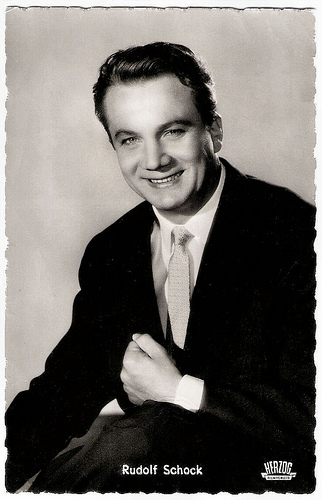
German postcard by Kolibri-Verlag G.m.b.H., Minden/Westf. no. 2080. Photo: Wega / Herzog-Film / Marszalek.
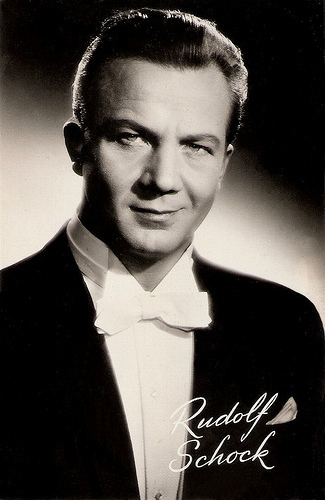
Dutch postcard by Uitg. Takken, Utrecht, no. 3409.
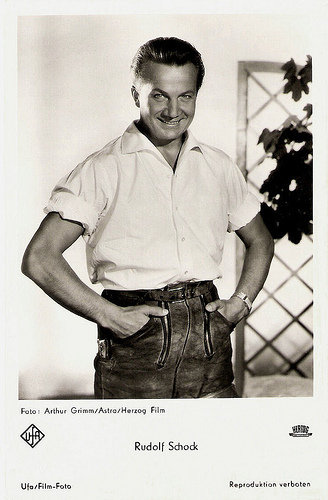
German postcard by Ufa, Berlin-Tempelhof, no. FK 3803. Photo: Arthur Grimm / Astra / Herzog Film.
That Italian 'Tear’ In His Voice
Rudolf Johann Schock was born in 1915 in Duisburg, Germany. In his hometown he made his first stage appearance in 1934 in the Opernchor (Opera Choir). In the 1930s he sang in opera choirs in Duisburg, Bayreuth, and Braunschweig.
Schock had his breakthough in 1944 in Don Pasquale at the Staatsoper in Berlin. In the following years he appeared in a.o. Madame Butterfly, Rigoletto, Die Entführung aus dem Serail, La Traviata, Der Rosenkavalier, and Die Zauberflöte (The Magic Flute).
Blessed with a mezza-voice that rivaled Beniamino Gigli in sweetness, he had that Italian ‘tear’ in his voice. His voice had an unique recognizable sound. He was one of the first Germans to sing at Covent Garden in 1949. He also made records and performed on the radio.
His first film appearance was in the comedy Es geht nicht ohne Gisela/Without Gisela it does not work (Hans Deppe, 1951).
In 1952 he was offered the lead in the Richard Tauber biography Du bist die Welt für mich/You Are the World for Me (Ernst Marischka, 1953). It made him an instant film star.
A dozen film operettas followed, including Der Fröhliche Wanderer/The Happy Wanderer (Hans Quest, 1955) with Elma Karlowa , Der Czardas-König/The Csardas Princess (Harald Philipp, 1958), and Das Dreimäderlhaus/Lilac Time (Ernst Marischka, 1958) with Karlheinz Böhm .
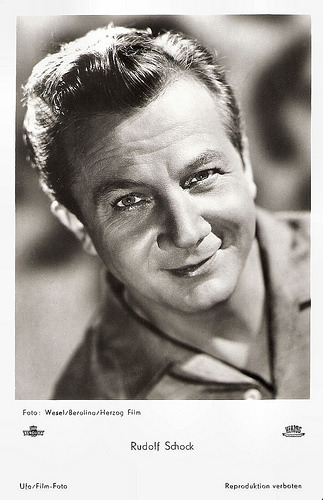
German postcard by Ufa, Berlin-Tempelhof, no. FK 1858. Photo: Wesel / Berolina / Herzog Film.
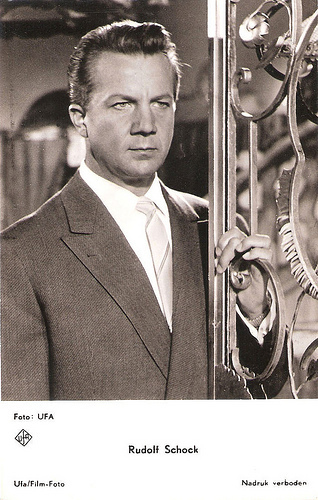
Dutch postcard by Gebr. Spanjersberg N.V., Rotterdam (Dutch licency holder of Universum-Film Aktiengesellschaft (Ufa), Berlin-Tempelhof), no. 1174. Photo: Ufa / Film-Foto.
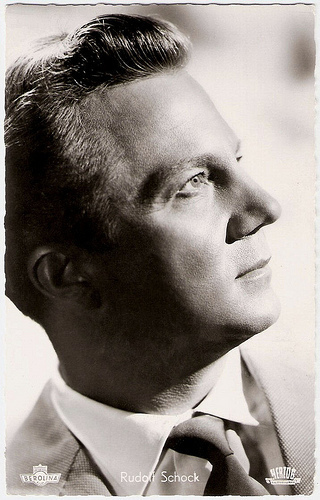
German postcard by Kolibri-Verlag G.m.b.H., Minden/Westf. no. 1638. Photo: Berolina / Herzog-Film / Wesel. Publicity still for Der fröhliche Wanderer/The Happy Wanderer (Hans Quest, 1955).
Heldentenor or Spinto Tenor?
Rudolf Schock's most impressive stage performances include the roles of Paul in Die Tote Stadt (Korngold), and multiple Puccini principles.
Wikipedia mentions that his voice fell almost ideally into the heldentenor fach, but Schock explored roles slanted more towards a spinto tenor with effectiveness. Colored distinctly with a rich baritonal quality, Schock's instrument demonstrates impressive flexibility in range and a heroic ring even in its upper reaches.
Schock appeared in many TV adaptations of operettas. A highlight was Der Zigeunerbaron, under the musical direction of Robert Stolz.
Schock also appeared in many shows that were designed especially for him.
Rudolf Schock died in 1986 in Düren-Gürzenich by a heart failure. He was married to ballet dancer Gisela Behrends with whom he had two daughters, Isolde and Dagmar.
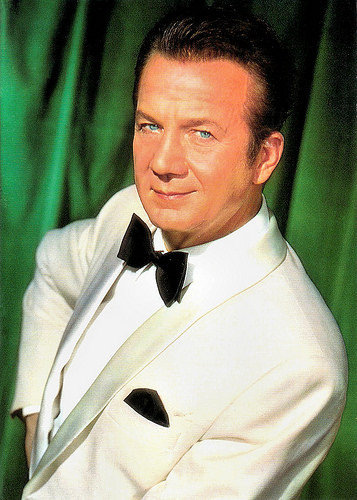
German card by Eurodisc. Photo: Grimm.
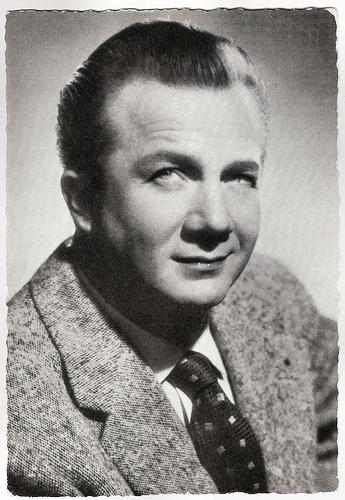
German postcard by WS-Druck, Wanne-Eickel, no. 267. Photo: Melodie-Film / Herzog-Film / Grimm (Arthur Grimm).
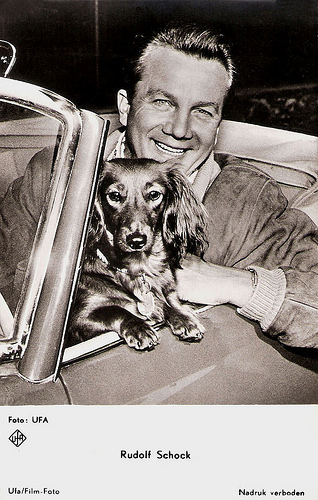
Dutch postcard by Gebr. Spanjersberg N.V., Rotterdam, no. 3656. Photo: Ufa.
Rudolf Schock sings Schenk mir dein Herz, Lucia (Give Me Your Heart, Lucia) in the film Stimme der Sehsucht/Voice of Longing (Thomas Engel, 1956). Source: fritz51289 (YouTube).
Sources: Fred Bredschneyder (Dutch), Rudolf Schock tribute site (Dutch/German), Wikipedia, and .

German postcard by Kolibri-Verlag G.m.b.H., Minden/Westf. no. 2080. Photo: Wega / Herzog-Film / Marszalek.

Dutch postcard by Uitg. Takken, Utrecht, no. 3409.

German postcard by Ufa, Berlin-Tempelhof, no. FK 3803. Photo: Arthur Grimm / Astra / Herzog Film.
That Italian 'Tear’ In His Voice
Rudolf Johann Schock was born in 1915 in Duisburg, Germany. In his hometown he made his first stage appearance in 1934 in the Opernchor (Opera Choir). In the 1930s he sang in opera choirs in Duisburg, Bayreuth, and Braunschweig.
Schock had his breakthough in 1944 in Don Pasquale at the Staatsoper in Berlin. In the following years he appeared in a.o. Madame Butterfly, Rigoletto, Die Entführung aus dem Serail, La Traviata, Der Rosenkavalier, and Die Zauberflöte (The Magic Flute).
Blessed with a mezza-voice that rivaled Beniamino Gigli in sweetness, he had that Italian ‘tear’ in his voice. His voice had an unique recognizable sound. He was one of the first Germans to sing at Covent Garden in 1949. He also made records and performed on the radio.
His first film appearance was in the comedy Es geht nicht ohne Gisela/Without Gisela it does not work (Hans Deppe, 1951).
In 1952 he was offered the lead in the Richard Tauber biography Du bist die Welt für mich/You Are the World for Me (Ernst Marischka, 1953). It made him an instant film star.
A dozen film operettas followed, including Der Fröhliche Wanderer/The Happy Wanderer (Hans Quest, 1955) with Elma Karlowa , Der Czardas-König/The Csardas Princess (Harald Philipp, 1958), and Das Dreimäderlhaus/Lilac Time (Ernst Marischka, 1958) with Karlheinz Böhm .

German postcard by Ufa, Berlin-Tempelhof, no. FK 1858. Photo: Wesel / Berolina / Herzog Film.

Dutch postcard by Gebr. Spanjersberg N.V., Rotterdam (Dutch licency holder of Universum-Film Aktiengesellschaft (Ufa), Berlin-Tempelhof), no. 1174. Photo: Ufa / Film-Foto.

German postcard by Kolibri-Verlag G.m.b.H., Minden/Westf. no. 1638. Photo: Berolina / Herzog-Film / Wesel. Publicity still for Der fröhliche Wanderer/The Happy Wanderer (Hans Quest, 1955).
Heldentenor or Spinto Tenor?
Rudolf Schock's most impressive stage performances include the roles of Paul in Die Tote Stadt (Korngold), and multiple Puccini principles.
Wikipedia mentions that his voice fell almost ideally into the heldentenor fach, but Schock explored roles slanted more towards a spinto tenor with effectiveness. Colored distinctly with a rich baritonal quality, Schock's instrument demonstrates impressive flexibility in range and a heroic ring even in its upper reaches.
Schock appeared in many TV adaptations of operettas. A highlight was Der Zigeunerbaron, under the musical direction of Robert Stolz.
Schock also appeared in many shows that were designed especially for him.
Rudolf Schock died in 1986 in Düren-Gürzenich by a heart failure. He was married to ballet dancer Gisela Behrends with whom he had two daughters, Isolde and Dagmar.

German card by Eurodisc. Photo: Grimm.

German postcard by WS-Druck, Wanne-Eickel, no. 267. Photo: Melodie-Film / Herzog-Film / Grimm (Arthur Grimm).

Dutch postcard by Gebr. Spanjersberg N.V., Rotterdam, no. 3656. Photo: Ufa.
Rudolf Schock sings Schenk mir dein Herz, Lucia (Give Me Your Heart, Lucia) in the film Stimme der Sehsucht/Voice of Longing (Thomas Engel, 1956). Source: fritz51289 (YouTube).
Sources: Fred Bredschneyder (Dutch), Rudolf Schock tribute site (Dutch/German), Wikipedia, and .
Published on November 15, 2014 23:00
November 14, 2014
Ein blonder Traum (1932)
Today's film special is about one of the biggest box office successes of the Weimar Republic, the witty and enjoyable musical comedy Ein blonder Traum/Happy Ever After (Paul Martin, 1932). It featured the German dream couple of the 1930s, Lilian Harvey and Willy Fritsch, and Viennese actor-director Willi Forst.
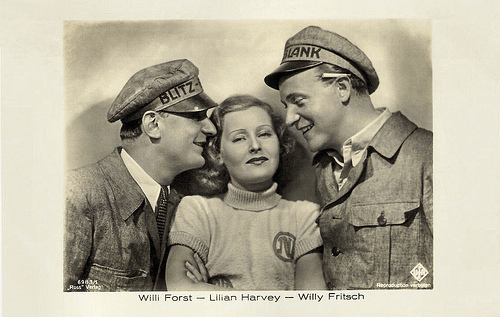
German postcard by Ross Verlag, no. 6983/1. Photo: Ufa. Lilian Harvey, Willi Forst and Willy Fritsch in the musical comedy Ein blonder Traum/Happy Ever After (Paul Martin, 1932).
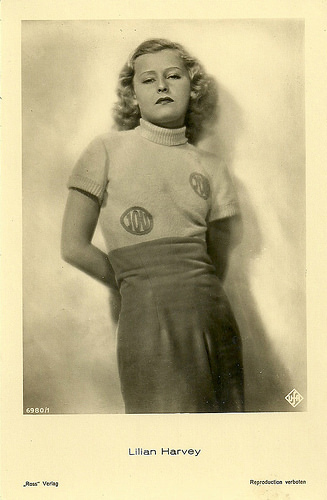
German postcard by Ross Verlag, no. 6980/1, 1931-1932. Photo: Ufa. Lilian Harvey in Ein blonder Traum/Happy Ever After (Paul Martin, 1932).
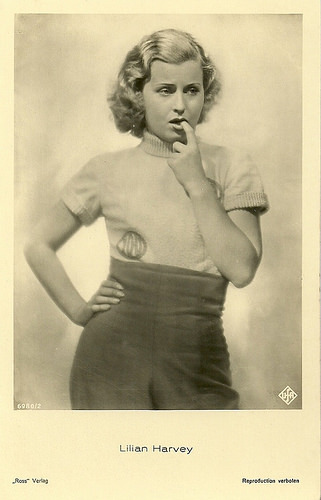
German postcard by Ross Verlag, no. 6980/2. Photo: Ufa. Photo Atelier Jacobi, Berlin. Lilian Harvey in Ein blonder Traum (Paul Martin, 1932).
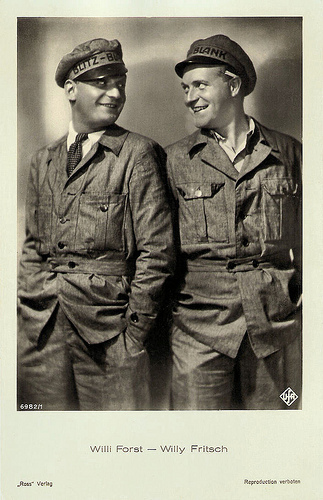
German postcard by Ross Verlag, no. 6982/1, 1931-1932. Photo: Ufa. Willi Forst and Willy Fritsch in Ein blonder Traum/Happy Ever After (Paul Martin, 1932).
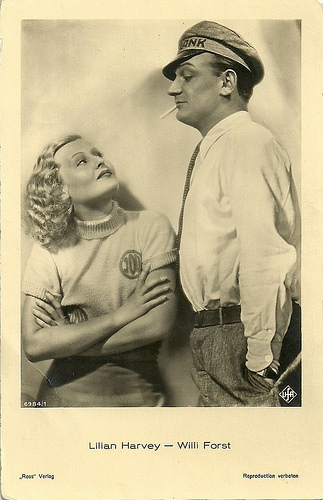
German postcard by Ross Verlag, no. 6984/1, 1931-1932. Photo: Ufa. Lilian Harvey and Willi Forst in Ein blonder Traum/Happy Ever After (Paul Martin, 1932).
Blitz-Blank
Ein blonder Traum/Happy Ever After is situated in Berlin, during the Depression of the early 1930s. Two window cleaners of the Blitz-Blank company, Willy I and Willy II ( Willi Forst and Willy Fritsch ), pedal with ladder and washing utensils crisscross through the city, from job to job, from house to house.
One day the blonde Jou-Jou ( Lilian Harvey ) enters their lives. They see her through the window of the American Consulate General. When Jou-Jou is about to be thrown out of the house by the rough porter, the two friends show their chivalrous side.
Jou-Jou, who earned her living as a projectile in a traveling circus, dreams of a film career in America. A certain Mr. Merryman, allegedly a major Hollywood mogul, has once promised her a career in the movies - against payment of a fee of $ 25.
The two Willy's want to help the girl. They decide to take care of her and help her achieve success.
The two lifelong friends take her home with them, so she and her shaggy mutt, called Buffalo, get a roof over their heads. Both window cleaners live poor but happily in cranky railway wagons in the middle of the meadow, far from the gates of the city.
Inevitably, both Willy I and Willy II fall in love with 'the blonde dream' and their friendship will be tested.
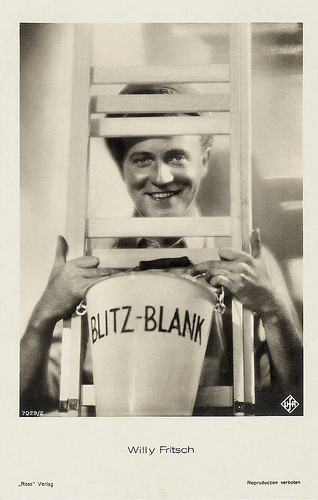
German postcard by Ross Verlag, no. 7029/2, 1932-1933. Photo: Ufa. Willy Fritsch in Ein blonder Traum/Happy Ever After (Paul Martin, 1932).
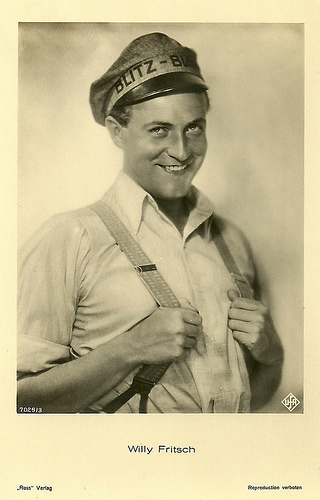
German postcard by Ross Verlag, no. 7029/3, 1932-1933. Photo: Ufa. Willy Fritsch in Ein blonder Traum/Happy Ever After (Paul Martin, 1932).
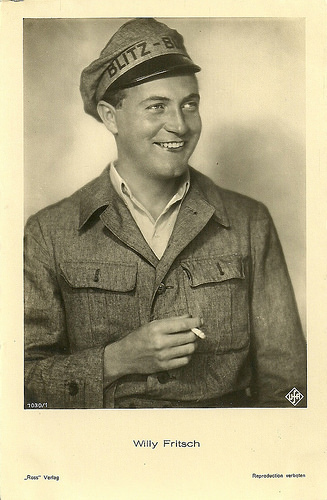
German postcard by Ross Verlag, no. 7030/1, 1932-1933. Photo: Ufa. Willy Fritsch in Ein blonder Traum/Happy Ever After (Paul Martin, 1932).
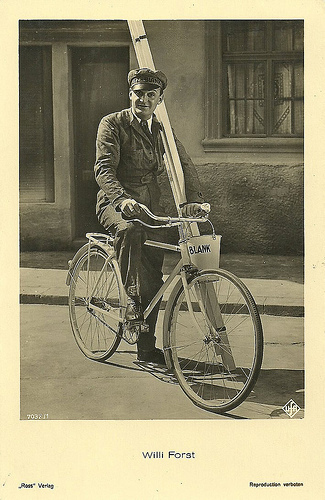
German postcard by Ross Verlag, no. 7032/1, 1932-1933. Photo: Ufa. Willi Forst in Ein blonder Traum/Happy Ever After (Paul Martin, 1932).
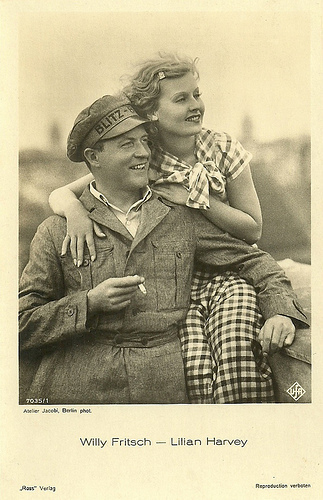
German postcard by Ross Verlag, no. 7035/1, 1932-1933. Photo: Ufa. Willy Fritsch and Lilian Harvey in Ein blonder Traum/Happy Ever After (Paul Martin, 1932).
Evergreens
Ein blonder Traum/Happy Ever After was directed by the Hungarian-born Paul Martin. It was his first sole directorial effort. Lilian Harvey , who was his partner, had promoted the quite inexperienced young director at the Ufa offices. The screenplay was written by Walter Reisch and the young Billy Wilder.
Werner Richard Heymann composed with music by Gérard Jacobson the songs Wir zahlen keine Miete mehr, wir sind im Grünen zuhaus (We no longer pay rent, we are at home in the countryside) and Irgendwo auf der Welt gibt's ein kleines bißchen Gluck (Somewhere in the world there's a little bit of luck). Both songs became evergreens. Heymann went on to have a career composing film scores in Hollywood after the Nazi takeover in Germany.
When the film went in premiere in Berlin, on 23 September 1932, the censors banned it for the youth, but a month later, on 27 October 1932, the ban was lifted again and the film was released for the youth. Ein blonder Traum/Happy Ever After became one of the biggest box office successes in the late phase of the Weimar Republic.
Simultaneously with the German version, there were two alternate language versions in French and English produced. In both versions Harvey repeated her part. The French version was called Un Rêve blond and had Henri Garat in the Fritsch role and Pierre Brasseur in the Forst role. The British version was entitled Happy Ever After, the two Willys were played by Jack Hulbert and Sonnie Hale.
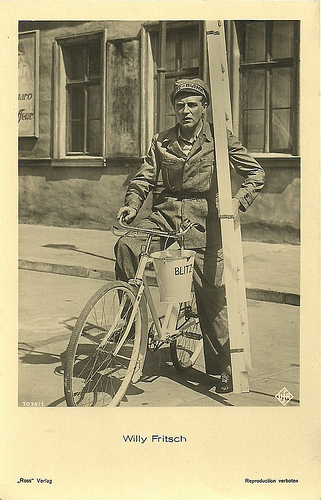
German postcard by Ross Verlag, no. 7036/1, 1932-1933. Photo: Ufa. Willy Fritsch in Ein blonder Traum/Happy Ever After (Paul Martin, 1932).
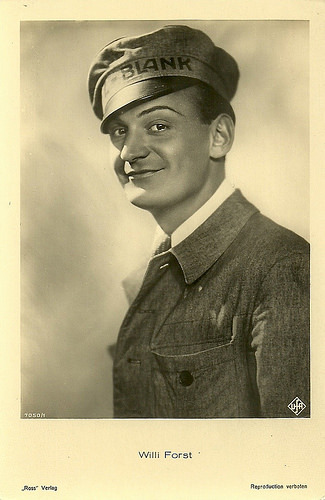
German postcard by Ross Verlag, no. 7050/1, 1932-1933. Photo: Ufa. Willi Forst in Ein blonder Traum/Happy Ever After (Paul Martin, 1932).
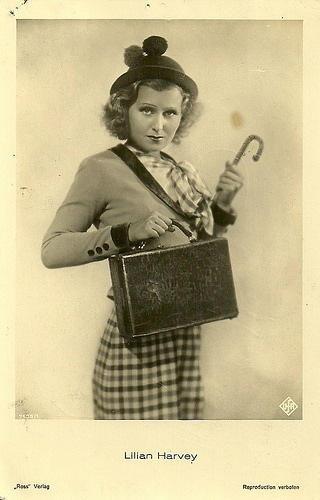
German postcard by Ross Verlag, no. 7135/1. Photo: Ufa. Photo Atelier Jacobi, Berlin. Lilian Harvey in Ein blonder Traum (Paul Martin, 1932).
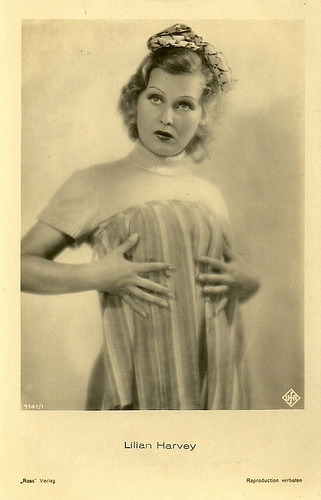
German postcard by Ross Verlag, no. 7141/1. Photo: Ufa. Photo Atelier Jacobi, Berlin. Lilian Harvey in Ein blonder Traum (Paul Martin, 1932).
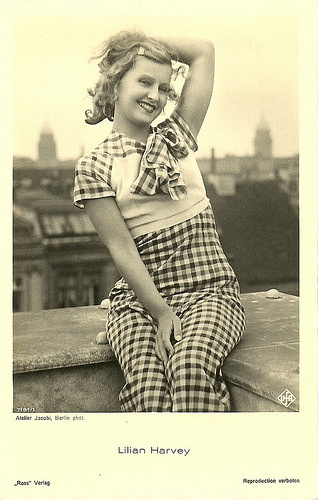
German postcard by Ross Verlag, no. 7191/1. Photo: Ufa. Photo Atelier Jacobi, Berlin. Lilian Harvey in Ein blonder Traum (Paul Martin, 1932).
An amusing and innovative daydream
One of the highlights in the film is an amusing and innovative daydream sequence in which Jou-Jou ( Lilian Harvey ) dreams that she and her two gallants run in a train out of the city of Berlin under the Atlantic Ocean to NYC and across to Hollywood.
Upon their arrival in New York City, even the Statue of Liberty beckons them. In Hollywood, however, everybody only makes fun of her. Then Jou-Jou wakes up with the words 'Now I have dreamed'.
Six months later, in January 1933, Lilian Harvey actually arrived in Hollywood. Though she starred in a few films for Fox, Harvey was unable to make it in the USA and she returned to Germany.
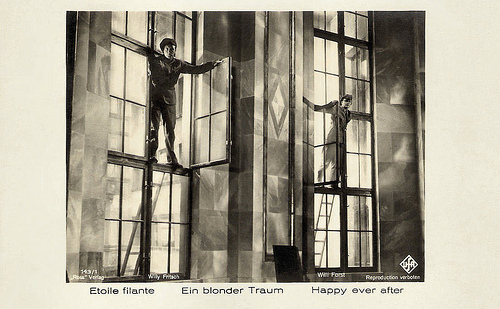
German postcard by Ross Verlag, no. 143/1. Photo: Ufa. Publicity still for Ein blonder Traum/Happy Ever After (Paul Martin, 1932).
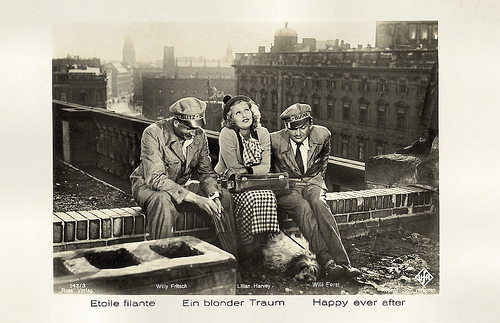
German postcard by Ross Verlag, no. 143/3. Photo: Ufa. Publicity still for Ein blonder Traum/Happy Ever After (Paul Martin, 1932).
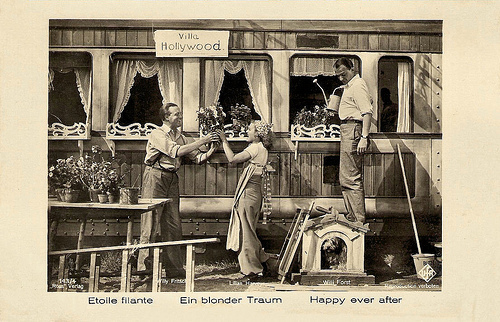
German postcard by Ross Verlag, no. 143/4. Photo: Ufa. Publicity still for Ein blonder Traum/Happy Ever After (Paul Martin, 1932).

German postcard by Ross Verlag, no. 143/5. Photo: Ufa. Lilian Harvey and Paul Hörbiger in Ein blonder Traum/Happy Ever After (Paul Martin, 1932).

German postcard by Ross Verlag, no. 143/6 Photo: Ufa. Willi Forst, Lilian Harvey and Willy Fritsch in Ein blonder Traum/Happy Ever After (Paul Martin, 1932).
Sources: AllMovie, Wikipedia (German) and IMDb.

German postcard by Ross Verlag, no. 6983/1. Photo: Ufa. Lilian Harvey, Willi Forst and Willy Fritsch in the musical comedy Ein blonder Traum/Happy Ever After (Paul Martin, 1932).

German postcard by Ross Verlag, no. 6980/1, 1931-1932. Photo: Ufa. Lilian Harvey in Ein blonder Traum/Happy Ever After (Paul Martin, 1932).

German postcard by Ross Verlag, no. 6980/2. Photo: Ufa. Photo Atelier Jacobi, Berlin. Lilian Harvey in Ein blonder Traum (Paul Martin, 1932).

German postcard by Ross Verlag, no. 6982/1, 1931-1932. Photo: Ufa. Willi Forst and Willy Fritsch in Ein blonder Traum/Happy Ever After (Paul Martin, 1932).

German postcard by Ross Verlag, no. 6984/1, 1931-1932. Photo: Ufa. Lilian Harvey and Willi Forst in Ein blonder Traum/Happy Ever After (Paul Martin, 1932).
Blitz-Blank
Ein blonder Traum/Happy Ever After is situated in Berlin, during the Depression of the early 1930s. Two window cleaners of the Blitz-Blank company, Willy I and Willy II ( Willi Forst and Willy Fritsch ), pedal with ladder and washing utensils crisscross through the city, from job to job, from house to house.
One day the blonde Jou-Jou ( Lilian Harvey ) enters their lives. They see her through the window of the American Consulate General. When Jou-Jou is about to be thrown out of the house by the rough porter, the two friends show their chivalrous side.
Jou-Jou, who earned her living as a projectile in a traveling circus, dreams of a film career in America. A certain Mr. Merryman, allegedly a major Hollywood mogul, has once promised her a career in the movies - against payment of a fee of $ 25.
The two Willy's want to help the girl. They decide to take care of her and help her achieve success.
The two lifelong friends take her home with them, so she and her shaggy mutt, called Buffalo, get a roof over their heads. Both window cleaners live poor but happily in cranky railway wagons in the middle of the meadow, far from the gates of the city.
Inevitably, both Willy I and Willy II fall in love with 'the blonde dream' and their friendship will be tested.

German postcard by Ross Verlag, no. 7029/2, 1932-1933. Photo: Ufa. Willy Fritsch in Ein blonder Traum/Happy Ever After (Paul Martin, 1932).

German postcard by Ross Verlag, no. 7029/3, 1932-1933. Photo: Ufa. Willy Fritsch in Ein blonder Traum/Happy Ever After (Paul Martin, 1932).

German postcard by Ross Verlag, no. 7030/1, 1932-1933. Photo: Ufa. Willy Fritsch in Ein blonder Traum/Happy Ever After (Paul Martin, 1932).

German postcard by Ross Verlag, no. 7032/1, 1932-1933. Photo: Ufa. Willi Forst in Ein blonder Traum/Happy Ever After (Paul Martin, 1932).

German postcard by Ross Verlag, no. 7035/1, 1932-1933. Photo: Ufa. Willy Fritsch and Lilian Harvey in Ein blonder Traum/Happy Ever After (Paul Martin, 1932).
Evergreens
Ein blonder Traum/Happy Ever After was directed by the Hungarian-born Paul Martin. It was his first sole directorial effort. Lilian Harvey , who was his partner, had promoted the quite inexperienced young director at the Ufa offices. The screenplay was written by Walter Reisch and the young Billy Wilder.
Werner Richard Heymann composed with music by Gérard Jacobson the songs Wir zahlen keine Miete mehr, wir sind im Grünen zuhaus (We no longer pay rent, we are at home in the countryside) and Irgendwo auf der Welt gibt's ein kleines bißchen Gluck (Somewhere in the world there's a little bit of luck). Both songs became evergreens. Heymann went on to have a career composing film scores in Hollywood after the Nazi takeover in Germany.
When the film went in premiere in Berlin, on 23 September 1932, the censors banned it for the youth, but a month later, on 27 October 1932, the ban was lifted again and the film was released for the youth. Ein blonder Traum/Happy Ever After became one of the biggest box office successes in the late phase of the Weimar Republic.
Simultaneously with the German version, there were two alternate language versions in French and English produced. In both versions Harvey repeated her part. The French version was called Un Rêve blond and had Henri Garat in the Fritsch role and Pierre Brasseur in the Forst role. The British version was entitled Happy Ever After, the two Willys were played by Jack Hulbert and Sonnie Hale.

German postcard by Ross Verlag, no. 7036/1, 1932-1933. Photo: Ufa. Willy Fritsch in Ein blonder Traum/Happy Ever After (Paul Martin, 1932).

German postcard by Ross Verlag, no. 7050/1, 1932-1933. Photo: Ufa. Willi Forst in Ein blonder Traum/Happy Ever After (Paul Martin, 1932).

German postcard by Ross Verlag, no. 7135/1. Photo: Ufa. Photo Atelier Jacobi, Berlin. Lilian Harvey in Ein blonder Traum (Paul Martin, 1932).

German postcard by Ross Verlag, no. 7141/1. Photo: Ufa. Photo Atelier Jacobi, Berlin. Lilian Harvey in Ein blonder Traum (Paul Martin, 1932).

German postcard by Ross Verlag, no. 7191/1. Photo: Ufa. Photo Atelier Jacobi, Berlin. Lilian Harvey in Ein blonder Traum (Paul Martin, 1932).
An amusing and innovative daydream
One of the highlights in the film is an amusing and innovative daydream sequence in which Jou-Jou ( Lilian Harvey ) dreams that she and her two gallants run in a train out of the city of Berlin under the Atlantic Ocean to NYC and across to Hollywood.
Upon their arrival in New York City, even the Statue of Liberty beckons them. In Hollywood, however, everybody only makes fun of her. Then Jou-Jou wakes up with the words 'Now I have dreamed'.
Six months later, in January 1933, Lilian Harvey actually arrived in Hollywood. Though she starred in a few films for Fox, Harvey was unable to make it in the USA and she returned to Germany.

German postcard by Ross Verlag, no. 143/1. Photo: Ufa. Publicity still for Ein blonder Traum/Happy Ever After (Paul Martin, 1932).

German postcard by Ross Verlag, no. 143/3. Photo: Ufa. Publicity still for Ein blonder Traum/Happy Ever After (Paul Martin, 1932).

German postcard by Ross Verlag, no. 143/4. Photo: Ufa. Publicity still for Ein blonder Traum/Happy Ever After (Paul Martin, 1932).

German postcard by Ross Verlag, no. 143/5. Photo: Ufa. Lilian Harvey and Paul Hörbiger in Ein blonder Traum/Happy Ever After (Paul Martin, 1932).

German postcard by Ross Verlag, no. 143/6 Photo: Ufa. Willi Forst, Lilian Harvey and Willy Fritsch in Ein blonder Traum/Happy Ever After (Paul Martin, 1932).
Sources: AllMovie, Wikipedia (German) and IMDb.
Published on November 14, 2014 22:00
November 13, 2014
Walter Rilla
German actor Walter Rilla (1894-1980) began his career in silent films, and appeared in over 130 films between 1922 and 1977. In 1933 he took his family and fled the Nazi regime. In London he played vile, foreign-tongued villains in spy films. He returned to Germany in the 1950s and wrote and directed for TV.
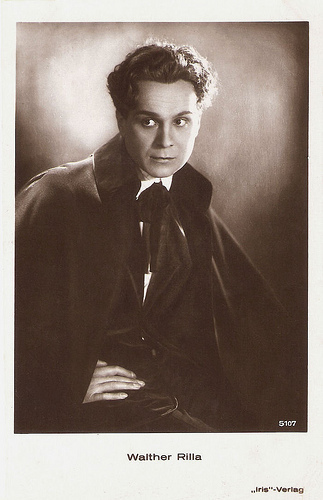
Austrian postcard by Iris-Verlag, no. 5107.
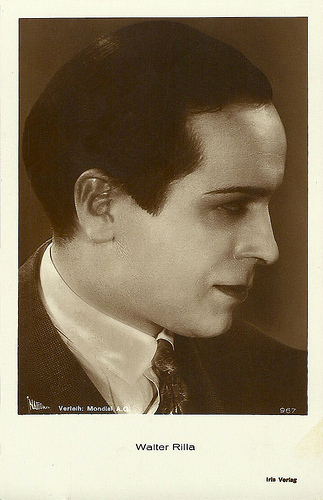
Austrian postcard by Iris Verlag, no. 967, 1927-1928. Photo: Mondial / National.
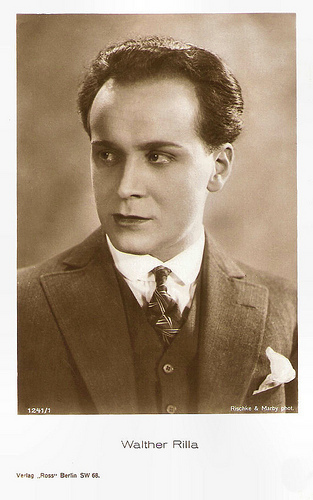
German postcard by Ross Verlag, no. 1241/1, 1927-1928. Photo: Rischke & Marby.
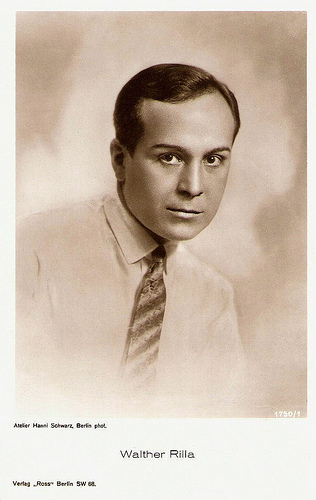
German postcard by Ross Verlag, no. 1750/1, 1927-1928. Photo: Hanni Schwarz, Berlin.
One of the Most Important German Character Actors
Walter Rilla was born Walter Wilhelm Karl Ernst Rilla in Neunkirchen (near Saarbrücken), Germany, in 1894. He was the son of railway engineer Friedrich Wilhelm Rilla and his wife Caroline, née Gründer.
Rilla visited the Fridericianum school in Königsberg and the University of Königsberg. He studied literature, art history and philosophy in Königsberg, Breslau, Lausanne and Berlin. He worked as a journalist for the Neuesten Breslauer Nachrichten (the Latest Breslau News).
In 1919 he founded the literary journal Erde (Earth). At the time, he was involved with the Communist Party and, when established with the leftish KAPD party. From 1920 on, he worked as a story editor for the Berliner Theater.
He made his film debut with a small role as the death angel in the Gerhart Hauptmann adaptation Hanneles Himmelfahrt/Hannele's Ascension (Urban Gad, 1922). Soon Rilla became one of the most important German character actors and worked with such other prominent directors as Victor Janson, Max Mack, and Reinhold Schünzel .
In 1924 he appeared in one of F. W. Murnau's rare attempts at comedy, the hilarious Die Finanzen des Grossherzogs/The Finances of the Grand Duke (Friedrich Wilhelm Murnau, 1924) starring Alfred Abel . A year later he starred opposite Jane Novak in the German-British coproduction Die Prinzessin und der Geiger/The Blackguard (Graham Cutts, 1925) written by the then 26 years-old Alfred Hitchcock.
In 1926 Rilla starred opposite Elisabeth Bergner and Conrad Veidt in Der Geigenspieler von Florenz/Impetuous Youth (Paul Czinner, 1926), and two years later he costarred with Carmen Boni and Marlene Dietrich in Prinzessin Olala/Art of Love (Robert Land, 1928).
He made an easy transition into sound film. He played for example Baron Hans von Velten in Namensheirat/Marriage in Name Only (Heinz Paul, 1930), Robert in Männer um Lucie/Men Around Lucie (Alexander Korda, 1931) with Liane Haid , and Lord Windermere in Lady Windermeres Fächer/Lady Windermere's Fan (Heinz Hilpert, 1935).
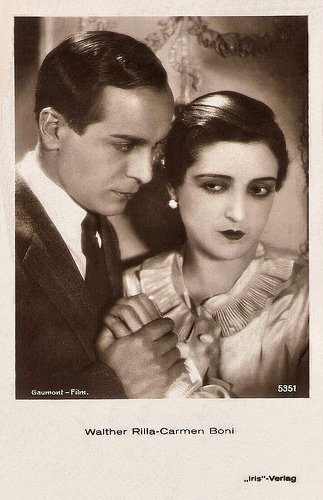
Austrian postcard by Iris-Verlag, no. 5351. Photo: Gaumont-Film. With Carmen Boni .
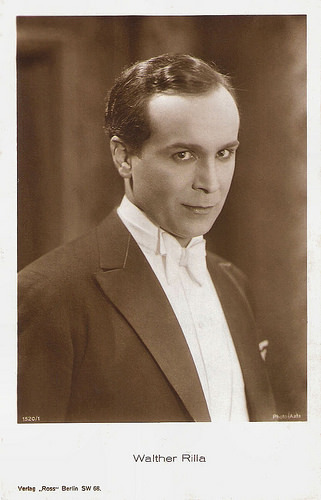
German postcard by Ross Verlag, no. 1520/1, 1927-1928. Photo: Aafa.
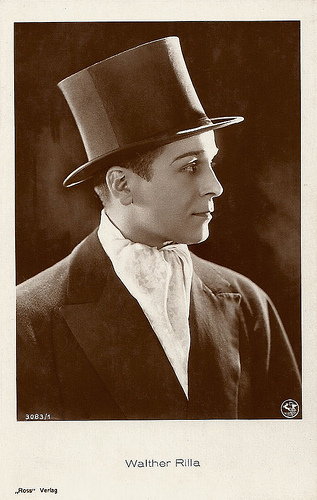
German postcard by Ross Verlag, no. 3083/1, 1928-1929. Photo: Phoebus Film.
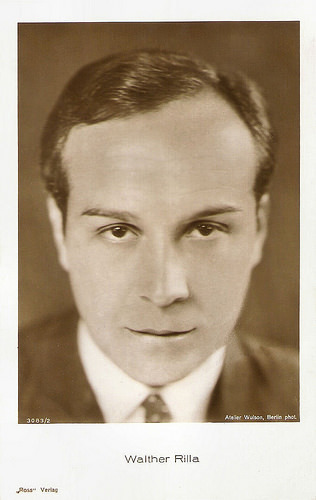
German postcard by Ross Verlag, no. 3083/2, 1928-1929. Photo: Atelier Wulson, Berlin.
Escaping the Rising Power of Hitler
In 1933 Walter Rilla moved with his family to London to escape the rising power of Adolph Hitler. His wife was Jewish and he refused to separate from her.
He had no trouble establishing himself in British films after 1933. He started out in the hits The Scarlet Pimpernel (Harold Young, 1934) featuring Leslie Howard , and Abdul the Damned (Karl Grune, 1935) with Fritz Kortner .
Rilla only appeared in character parts, but he did work with respected directors like Robert Siodmak and Herbert Wilcox on successful British and French productions. He was seen for example as Prince Ernst in the Wilcox staged historical drama Victoria the Great (Herbert Wilcox, 1937) with Anna Neagle , and a year later, again in that role in the sequel, Sixty Glorious Years/Queen of Destiny (Herbert Wilcox, 1938). Other films were the adventure Hell's Cargo/Dangerous Cargo (Harold Huth, 1939), and the romance Black Eyes/False Rapture (Herbert Brenon, 1939).
In 1940 he became a British citizen. During the war years Rilla specialized in sinister foreigners — and, of course, Nazis - in such war films as The Adventures of Tartu/Sabotage Agent (Harold S. Buquet, 1943) starring Robert Donat and Valerie Hobson , and Candlelight in Algeria (George King, 1944) starring James Mason .
Aside from acting, Walter Rilla worked in the UK as a producer and screenwriter, and as an author of radio plays for the BBC. He also published some novels. After the war, Rilla continued his evil film ways in a progression of appearances as sultans, megalomaniacs and corporate villains. Probably the most interesting of these films is the thriller Desperate Moment (Compton Bennett, 1953) starring Dirk Bogarde as a man who tries to clear himself of murder in post-war Germany. Rilla directed one film himself, Behold the Man! (1951).
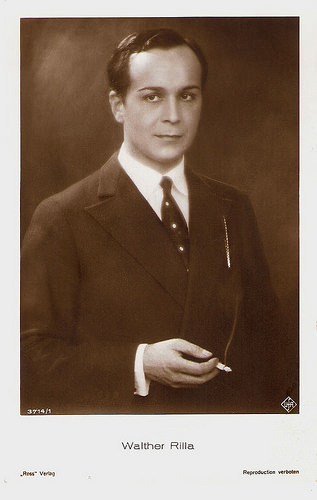
German postcard by Ross Verlag, no. 3714/1, 1928-1929. Photo: Ufa.
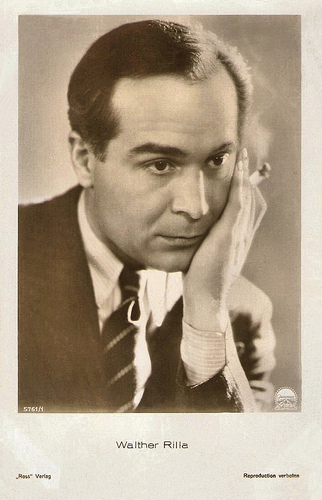
German postcard by Ross Verlag, no. 5761/1, 1930-1931. Photo: Paramount.
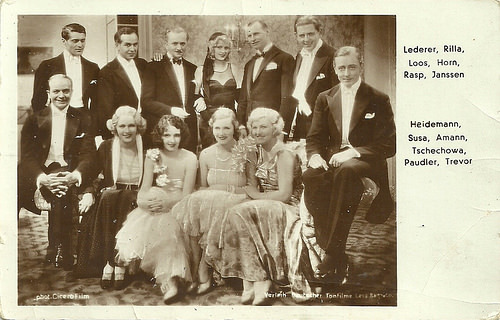
German postcard. Photo: Cicero Film / Distribution Deutsche Tonfilme.
The 'fine fleur' of late silent German cinema stars, united for a photo for an early sound film company. Standing left to right: Francis/Franz Lederer, Walter Rilla, Theodor Loos, Camilla Horn, Fritz Rasp and Walter Janssen, Sitting left to right: Paul Heidemann, Charlotte Susa, Betty Amann, Olga Tschechowa, Maria Paudler and Jack Trevor. The postcard was possibly promotion for the early sound comedy Die grosse Sehnsucht/The Great Longing (Stefan Szekely/Steve Sekely, 1930), in which all acted, mostly as themselves - only Loos and Horn played characters. The plot was an excuse for 35 stars to debut in a talking picture.
Back in Germany
In 1957 Walter Rilla returned to Germany. There he had his first role in the Thomas Mann adaptation Bekenntnisse des Hochstaplers Felix Krull/Confessions of Felix Krull (Kurt Hoffmann, 1957) alongside Horst Buchholz .
He followed this hit with a role in an equally popular film, Scampolo (Alfred Weidenmann, 1958) starring Romy Schneider . He then played in the last Mario Lanza vehicle, For the First Time (Rudolph Maté, 1959).
Rilla appeared in the Edgar Wallace film adaptations Der Fälscher von London/The Forger Of London (Harald Reinl, 1960) and Zimmer 13/Room 13 (Harald Reinl, 1964) with Karin Dor . He also appeared as Dr. Mabuse in Das Testament des Dr. Mabuse/The Terror of Doctor Mabuse (1962) opposite Gert Fröbe, and Dr. Mabuse and Scotland Yard jagt Dr. Mabuse/Dr. Mabuse vs. Scotland Yard (Paul May, 1963) opposite Peter van Eyck .
In addition, Rilla was a writer, screenwriter, producer, and director of several stage and TV productions, and he worked as a television actor. From 1957 on he had an engagement at the Kleine Komödie in München (Munich). In 1966 he was awarded the Filmband in Gold for his work in German cinema.
Later films include the spaghetti western I giorni dell'ira/Gunlaw (Tonino Valerii, 1967) starring Lee van Cleef and Giuliano Gemma , the cult thriller Der Teufel kam aus Akasava/The Devil Came from Akasava (Jesus Franco, 1971) with Fred Williams and Soledad Miranda, and the interesting surrealistic horror film Malpertuis/The Legend of Doom House (Harry Kümel, 1971) with Mathieu Carrière and Orson Welles .
He made his last screen appearance in the Thomas Mann adaptation Unordnung und frühes Leid/Disorder and Early Torment (Frans Seitz, 1977) with Ruth Leuwerik and Martin Held .
Walter Rilla died in 1980 in Rosenheim, Germany. He had been married twice. First he married Theresa Klausner, who died in 1948. They had a son, prominent British-based film screenwriter and director Wolf Rilla (1920-2005). Since 1959, Walter Rilla was married to the French writer Alix Degrelle-Hirth du Frênes.
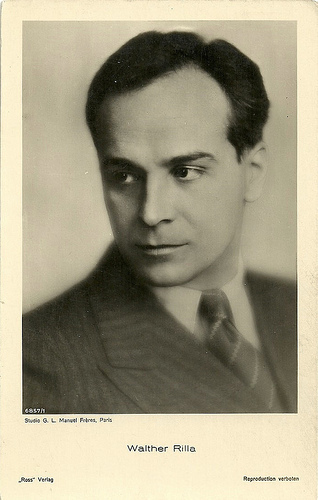
German postcard by Ross Verlag, no. 6857/1, 1931-1932. Photo: Studio G.L. Manuel Frères, Paris.
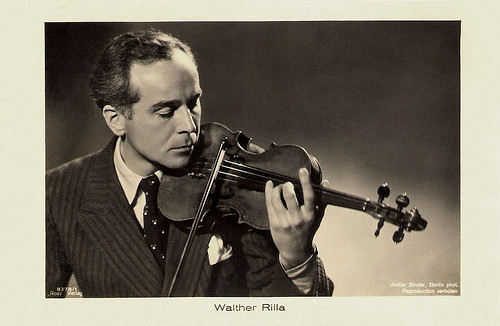
German postcard by Ross Verlag, no. 8378/1, 1933-1934. Photo: Atelier Binder, Berlin. Publicity still for Der Springer von Pontresina/The Champion of Pontresina (Herbert Selpin, 1934).
Trailer of Zimmer 13/Room 13 (1964). Source: R6dw6C (YouTube).
Sources: Stephanie D’heil (Steffi-line), Hal Erickson (AllMovie), Wikipedia (German), and .

Austrian postcard by Iris-Verlag, no. 5107.

Austrian postcard by Iris Verlag, no. 967, 1927-1928. Photo: Mondial / National.

German postcard by Ross Verlag, no. 1241/1, 1927-1928. Photo: Rischke & Marby.

German postcard by Ross Verlag, no. 1750/1, 1927-1928. Photo: Hanni Schwarz, Berlin.
One of the Most Important German Character Actors
Walter Rilla was born Walter Wilhelm Karl Ernst Rilla in Neunkirchen (near Saarbrücken), Germany, in 1894. He was the son of railway engineer Friedrich Wilhelm Rilla and his wife Caroline, née Gründer.
Rilla visited the Fridericianum school in Königsberg and the University of Königsberg. He studied literature, art history and philosophy in Königsberg, Breslau, Lausanne and Berlin. He worked as a journalist for the Neuesten Breslauer Nachrichten (the Latest Breslau News).
In 1919 he founded the literary journal Erde (Earth). At the time, he was involved with the Communist Party and, when established with the leftish KAPD party. From 1920 on, he worked as a story editor for the Berliner Theater.
He made his film debut with a small role as the death angel in the Gerhart Hauptmann adaptation Hanneles Himmelfahrt/Hannele's Ascension (Urban Gad, 1922). Soon Rilla became one of the most important German character actors and worked with such other prominent directors as Victor Janson, Max Mack, and Reinhold Schünzel .
In 1924 he appeared in one of F. W. Murnau's rare attempts at comedy, the hilarious Die Finanzen des Grossherzogs/The Finances of the Grand Duke (Friedrich Wilhelm Murnau, 1924) starring Alfred Abel . A year later he starred opposite Jane Novak in the German-British coproduction Die Prinzessin und der Geiger/The Blackguard (Graham Cutts, 1925) written by the then 26 years-old Alfred Hitchcock.
In 1926 Rilla starred opposite Elisabeth Bergner and Conrad Veidt in Der Geigenspieler von Florenz/Impetuous Youth (Paul Czinner, 1926), and two years later he costarred with Carmen Boni and Marlene Dietrich in Prinzessin Olala/Art of Love (Robert Land, 1928).
He made an easy transition into sound film. He played for example Baron Hans von Velten in Namensheirat/Marriage in Name Only (Heinz Paul, 1930), Robert in Männer um Lucie/Men Around Lucie (Alexander Korda, 1931) with Liane Haid , and Lord Windermere in Lady Windermeres Fächer/Lady Windermere's Fan (Heinz Hilpert, 1935).

Austrian postcard by Iris-Verlag, no. 5351. Photo: Gaumont-Film. With Carmen Boni .

German postcard by Ross Verlag, no. 1520/1, 1927-1928. Photo: Aafa.

German postcard by Ross Verlag, no. 3083/1, 1928-1929. Photo: Phoebus Film.

German postcard by Ross Verlag, no. 3083/2, 1928-1929. Photo: Atelier Wulson, Berlin.
Escaping the Rising Power of Hitler
In 1933 Walter Rilla moved with his family to London to escape the rising power of Adolph Hitler. His wife was Jewish and he refused to separate from her.
He had no trouble establishing himself in British films after 1933. He started out in the hits The Scarlet Pimpernel (Harold Young, 1934) featuring Leslie Howard , and Abdul the Damned (Karl Grune, 1935) with Fritz Kortner .
Rilla only appeared in character parts, but he did work with respected directors like Robert Siodmak and Herbert Wilcox on successful British and French productions. He was seen for example as Prince Ernst in the Wilcox staged historical drama Victoria the Great (Herbert Wilcox, 1937) with Anna Neagle , and a year later, again in that role in the sequel, Sixty Glorious Years/Queen of Destiny (Herbert Wilcox, 1938). Other films were the adventure Hell's Cargo/Dangerous Cargo (Harold Huth, 1939), and the romance Black Eyes/False Rapture (Herbert Brenon, 1939).
In 1940 he became a British citizen. During the war years Rilla specialized in sinister foreigners — and, of course, Nazis - in such war films as The Adventures of Tartu/Sabotage Agent (Harold S. Buquet, 1943) starring Robert Donat and Valerie Hobson , and Candlelight in Algeria (George King, 1944) starring James Mason .
Aside from acting, Walter Rilla worked in the UK as a producer and screenwriter, and as an author of radio plays for the BBC. He also published some novels. After the war, Rilla continued his evil film ways in a progression of appearances as sultans, megalomaniacs and corporate villains. Probably the most interesting of these films is the thriller Desperate Moment (Compton Bennett, 1953) starring Dirk Bogarde as a man who tries to clear himself of murder in post-war Germany. Rilla directed one film himself, Behold the Man! (1951).

German postcard by Ross Verlag, no. 3714/1, 1928-1929. Photo: Ufa.

German postcard by Ross Verlag, no. 5761/1, 1930-1931. Photo: Paramount.

German postcard. Photo: Cicero Film / Distribution Deutsche Tonfilme.
The 'fine fleur' of late silent German cinema stars, united for a photo for an early sound film company. Standing left to right: Francis/Franz Lederer, Walter Rilla, Theodor Loos, Camilla Horn, Fritz Rasp and Walter Janssen, Sitting left to right: Paul Heidemann, Charlotte Susa, Betty Amann, Olga Tschechowa, Maria Paudler and Jack Trevor. The postcard was possibly promotion for the early sound comedy Die grosse Sehnsucht/The Great Longing (Stefan Szekely/Steve Sekely, 1930), in which all acted, mostly as themselves - only Loos and Horn played characters. The plot was an excuse for 35 stars to debut in a talking picture.
Back in Germany
In 1957 Walter Rilla returned to Germany. There he had his first role in the Thomas Mann adaptation Bekenntnisse des Hochstaplers Felix Krull/Confessions of Felix Krull (Kurt Hoffmann, 1957) alongside Horst Buchholz .
He followed this hit with a role in an equally popular film, Scampolo (Alfred Weidenmann, 1958) starring Romy Schneider . He then played in the last Mario Lanza vehicle, For the First Time (Rudolph Maté, 1959).
Rilla appeared in the Edgar Wallace film adaptations Der Fälscher von London/The Forger Of London (Harald Reinl, 1960) and Zimmer 13/Room 13 (Harald Reinl, 1964) with Karin Dor . He also appeared as Dr. Mabuse in Das Testament des Dr. Mabuse/The Terror of Doctor Mabuse (1962) opposite Gert Fröbe, and Dr. Mabuse and Scotland Yard jagt Dr. Mabuse/Dr. Mabuse vs. Scotland Yard (Paul May, 1963) opposite Peter van Eyck .
In addition, Rilla was a writer, screenwriter, producer, and director of several stage and TV productions, and he worked as a television actor. From 1957 on he had an engagement at the Kleine Komödie in München (Munich). In 1966 he was awarded the Filmband in Gold for his work in German cinema.
Later films include the spaghetti western I giorni dell'ira/Gunlaw (Tonino Valerii, 1967) starring Lee van Cleef and Giuliano Gemma , the cult thriller Der Teufel kam aus Akasava/The Devil Came from Akasava (Jesus Franco, 1971) with Fred Williams and Soledad Miranda, and the interesting surrealistic horror film Malpertuis/The Legend of Doom House (Harry Kümel, 1971) with Mathieu Carrière and Orson Welles .
He made his last screen appearance in the Thomas Mann adaptation Unordnung und frühes Leid/Disorder and Early Torment (Frans Seitz, 1977) with Ruth Leuwerik and Martin Held .
Walter Rilla died in 1980 in Rosenheim, Germany. He had been married twice. First he married Theresa Klausner, who died in 1948. They had a son, prominent British-based film screenwriter and director Wolf Rilla (1920-2005). Since 1959, Walter Rilla was married to the French writer Alix Degrelle-Hirth du Frênes.

German postcard by Ross Verlag, no. 6857/1, 1931-1932. Photo: Studio G.L. Manuel Frères, Paris.

German postcard by Ross Verlag, no. 8378/1, 1933-1934. Photo: Atelier Binder, Berlin. Publicity still for Der Springer von Pontresina/The Champion of Pontresina (Herbert Selpin, 1934).
Trailer of Zimmer 13/Room 13 (1964). Source: R6dw6C (YouTube).
Sources: Stephanie D’heil (Steffi-line), Hal Erickson (AllMovie), Wikipedia (German), and .
Published on November 13, 2014 23:00
November 12, 2014
Geneviève Page
Long-necked, doe-eyed Geneviève Page (1927) starred in French, Italian, British and American films during a career spanning fifty years. The French actress often played glamorous roles in costume pictures as a delectable heroine who meets an untimely demise.
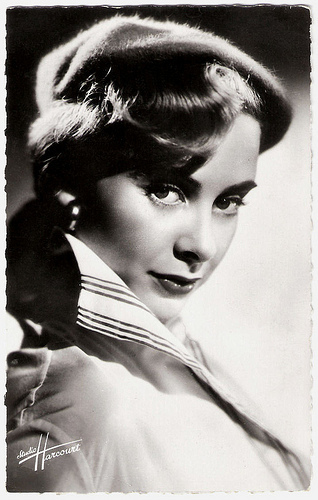
French postcard by Editions du Globe, Paris, no. 281. Photo: Studio Harcourt.
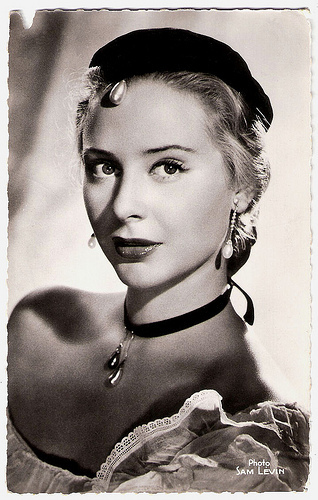
French postcard by Editions du Globe, Paris, no. 330. Photo: Sam Lévin.
Fanfan la Tulipe
Geneviève Page was born Geneviève Bonjean in Paris, France in 1927. Her father was Jacques Paul Bonjean, a well known French art-collector.
Her film début was in the murder mystery Pas de pitié pour les femmes/No Pity for Women (Christian Stengel, 1951) starring Simone Renant ( AllMovie mentions the documentary Ce Siecle A Cinquante Ans/This Is the Half Century (Denise Tua, 1949) as her first film appearance).
It was followed by the comedy adventure film Fanfan la Tulipe (Christian-Jaque, 1952) in which she played Madame de Pompadour, alongside Gérard Philipe and Gina Lollobrigida . This swashbuckler was an enormous popular success and in 1952, it won both the Silver Bear at the Berlin International Film Festival and the Best Director award at the Cannes Film Festival.
Since then, Page has appeared in French, Italian, British and American films. In Great-Britain, she appeared opposite David Niven in the romantic comedy The Silken Affair (Roy Kellino, 1956). Opposite Robert Mitchum she played in the American thriller Foreign Intrigue (Sheldon Reynolds, 1956).
In France she co-starred with Jean Marais in the comic fantasy Amour de poche/Girl in His Pocket (Pierre Kast, 1957) and in the spy parody L'honorable Stanislas, agent secret/How to Be a Spy Without Even Trying (Jean-Charles Dudrumet, 1963).
In Hollywood, she co-starred in the biographical film romance Song Without End a.k.a. The Story of Franz Liszt (1960) produced by Columbia Pictures. It was directed by Charles Vidor, who died during the shooting of the picture and he was replaced by George Cukor. The film starred Dirk Bogarde as Franz Liszt, Capucine as Princess Carolyne zu Sayn-Wittgenstein, and Page as Marie d'Agoult. The film won the Best Music score Academy Award for Morris Stoloff and Harry Sukman and the Golden Globe Award for Best Motion Picture (Musical).
Next, she appeared for Samuel Bronston Productions in the historical epic El Cid (Anthony Mann, 1961), a romanticized story of the life of the Christian Castilian knight ‘El Cid’ (Charlton Heston), who in the 11th century fought the North African Almoravides and ultimately contributed to the unification of Spain.
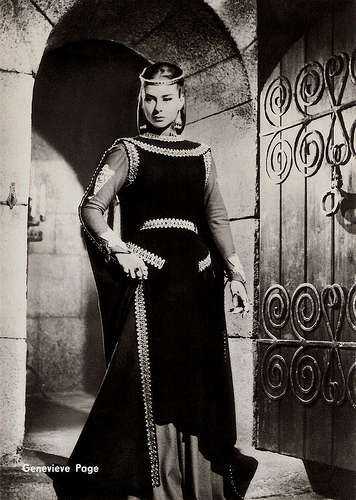
East-German postcard by VEB Progress Filmvertrieb, Berlin, no. 129/69. Photo: publicity still for El Cid (Anthony Mann, 1961).
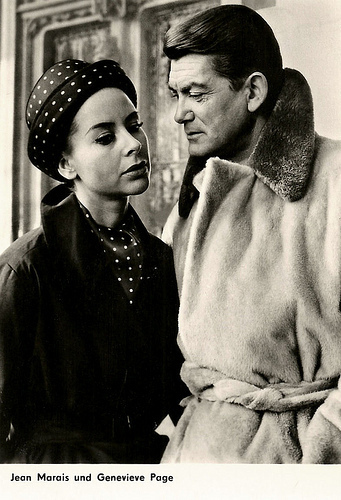
German postcard by Progress-Filmvertrieb, Berlin, no. 2416.Photo: publicity still of Jean Marais and Geneviève Page in the film Der ehrenwerte Stanislas/L'honorable Stanislas, l'agent secret (Jean-Charles Dudrumet, 1963).
Belle de Jour
Geneviève Page was a member of the international cast of the American action film Grand Prix (John Frankenheimer, 1966) with James Garner, Eva Marie Saint and Yves Montand . One of the ten highest grossing films of 1966, Grand Prix won three Academy Awards for its technical achievements.
One of her most famous films is Belle de Jour (Luis Bunuel, 1967). She played Madame Anais, who runs the high-class brothel, where Séverine ( Catherine Deneuve ) goes to work.
Page appeared with Deneuve again when she played Countess Larisch in the romantic tragedy Mayerling (Terence Young, 1968). Billy Wilder cast her as the mysterious villain in his The Private Life of Sherlock Holmes (1970) with Robert Stephens as Sherlock Holmes.
In France, she had a small part in the black comedy Buffet Froid (Bertrand Blier, 1979) with Gérard Dépardieu , and a bigger part in the thriller Mortelle Randonnée/Deadly Circuit (Claude Miller, 1983) with Isabelle Adjani as a serial killer and Michel Serrault as the detective who is on her trail. The film had a total of 916,868 admissions in France.
In the US, she appeared in Robert Altman's Beyond Therapy (1987) with Jeff Goldblum and in Altman’s segment of the anthology film Aria (1987). In Italy she starred in the drama Cartoline italiane/Italian Postcards (Memè Perlini, 1987).
Besides her film career, Geneviève Page had a long and distinguished career on stage. She was the winner of the 1980 Prix de la meilleure comédienne du syndicat de la critique (Best Actress award of the critics association) for her role in Les Larmes amères de Petra von Kant (The Bitter Tears of Petra von Kant) at the Théâtre national de Chaillot in Paris, and in 1996, she was nominated for the Molière Award (the French equivalent of the Tony Award) for her role in Colombe. She continued to act until 2003.
Geneviève Page has been married to Jean-Claude Bujard, a corporate director, since 1959 and they have two children.
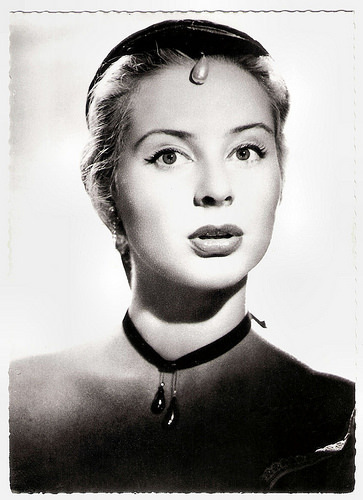
Yugoslavian postcard by ZK, no. 2190. Photo: Sam Lévin.
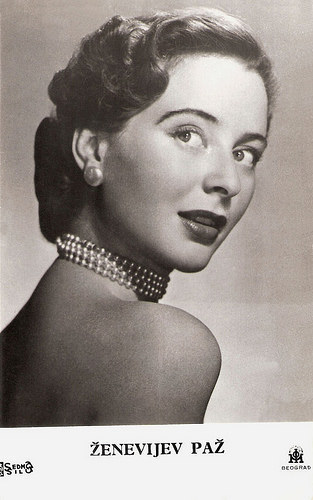
Yugoslavian postcard by IOM, Beograd. Photo: Sedmo Silo.
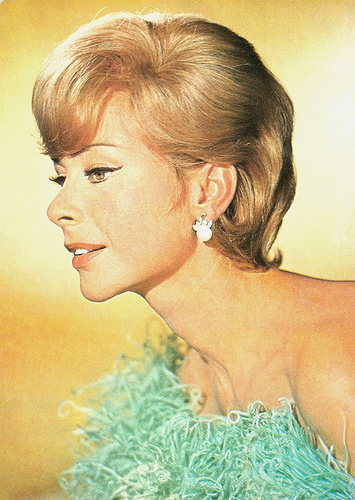
Romanian postcard by Casa Filmului Acin.
Sources: AllMovie, Wikipedia, and .

French postcard by Editions du Globe, Paris, no. 281. Photo: Studio Harcourt.

French postcard by Editions du Globe, Paris, no. 330. Photo: Sam Lévin.
Fanfan la Tulipe
Geneviève Page was born Geneviève Bonjean in Paris, France in 1927. Her father was Jacques Paul Bonjean, a well known French art-collector.
Her film début was in the murder mystery Pas de pitié pour les femmes/No Pity for Women (Christian Stengel, 1951) starring Simone Renant ( AllMovie mentions the documentary Ce Siecle A Cinquante Ans/This Is the Half Century (Denise Tua, 1949) as her first film appearance).
It was followed by the comedy adventure film Fanfan la Tulipe (Christian-Jaque, 1952) in which she played Madame de Pompadour, alongside Gérard Philipe and Gina Lollobrigida . This swashbuckler was an enormous popular success and in 1952, it won both the Silver Bear at the Berlin International Film Festival and the Best Director award at the Cannes Film Festival.
Since then, Page has appeared in French, Italian, British and American films. In Great-Britain, she appeared opposite David Niven in the romantic comedy The Silken Affair (Roy Kellino, 1956). Opposite Robert Mitchum she played in the American thriller Foreign Intrigue (Sheldon Reynolds, 1956).
In France she co-starred with Jean Marais in the comic fantasy Amour de poche/Girl in His Pocket (Pierre Kast, 1957) and in the spy parody L'honorable Stanislas, agent secret/How to Be a Spy Without Even Trying (Jean-Charles Dudrumet, 1963).
In Hollywood, she co-starred in the biographical film romance Song Without End a.k.a. The Story of Franz Liszt (1960) produced by Columbia Pictures. It was directed by Charles Vidor, who died during the shooting of the picture and he was replaced by George Cukor. The film starred Dirk Bogarde as Franz Liszt, Capucine as Princess Carolyne zu Sayn-Wittgenstein, and Page as Marie d'Agoult. The film won the Best Music score Academy Award for Morris Stoloff and Harry Sukman and the Golden Globe Award for Best Motion Picture (Musical).
Next, she appeared for Samuel Bronston Productions in the historical epic El Cid (Anthony Mann, 1961), a romanticized story of the life of the Christian Castilian knight ‘El Cid’ (Charlton Heston), who in the 11th century fought the North African Almoravides and ultimately contributed to the unification of Spain.

East-German postcard by VEB Progress Filmvertrieb, Berlin, no. 129/69. Photo: publicity still for El Cid (Anthony Mann, 1961).

German postcard by Progress-Filmvertrieb, Berlin, no. 2416.Photo: publicity still of Jean Marais and Geneviève Page in the film Der ehrenwerte Stanislas/L'honorable Stanislas, l'agent secret (Jean-Charles Dudrumet, 1963).
Belle de Jour
Geneviève Page was a member of the international cast of the American action film Grand Prix (John Frankenheimer, 1966) with James Garner, Eva Marie Saint and Yves Montand . One of the ten highest grossing films of 1966, Grand Prix won three Academy Awards for its technical achievements.
One of her most famous films is Belle de Jour (Luis Bunuel, 1967). She played Madame Anais, who runs the high-class brothel, where Séverine ( Catherine Deneuve ) goes to work.
Page appeared with Deneuve again when she played Countess Larisch in the romantic tragedy Mayerling (Terence Young, 1968). Billy Wilder cast her as the mysterious villain in his The Private Life of Sherlock Holmes (1970) with Robert Stephens as Sherlock Holmes.
In France, she had a small part in the black comedy Buffet Froid (Bertrand Blier, 1979) with Gérard Dépardieu , and a bigger part in the thriller Mortelle Randonnée/Deadly Circuit (Claude Miller, 1983) with Isabelle Adjani as a serial killer and Michel Serrault as the detective who is on her trail. The film had a total of 916,868 admissions in France.
In the US, she appeared in Robert Altman's Beyond Therapy (1987) with Jeff Goldblum and in Altman’s segment of the anthology film Aria (1987). In Italy she starred in the drama Cartoline italiane/Italian Postcards (Memè Perlini, 1987).
Besides her film career, Geneviève Page had a long and distinguished career on stage. She was the winner of the 1980 Prix de la meilleure comédienne du syndicat de la critique (Best Actress award of the critics association) for her role in Les Larmes amères de Petra von Kant (The Bitter Tears of Petra von Kant) at the Théâtre national de Chaillot in Paris, and in 1996, she was nominated for the Molière Award (the French equivalent of the Tony Award) for her role in Colombe. She continued to act until 2003.
Geneviève Page has been married to Jean-Claude Bujard, a corporate director, since 1959 and they have two children.

Yugoslavian postcard by ZK, no. 2190. Photo: Sam Lévin.

Yugoslavian postcard by IOM, Beograd. Photo: Sedmo Silo.

Romanian postcard by Casa Filmului Acin.
Sources: AllMovie, Wikipedia, and .
Published on November 12, 2014 23:00
November 11, 2014
Karel Gott
Schlager singer Karel Gott (1939) is the most successful male singer of the Czech Republic, who also had many successes in the German-speaking countries. He released more than 125 albums during his career, selling over 30 million records worldwide. In the annual national poll Český slavík, ‘the Sinatra of the East’ was thirty-eight times elected as the Most Favourite Male Singer.
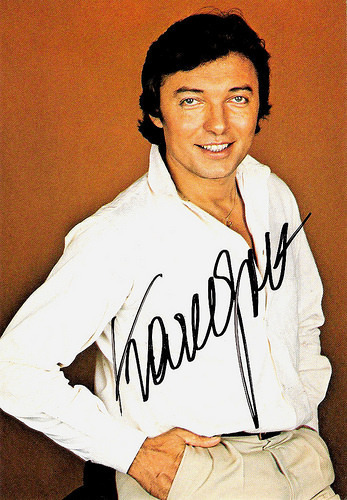
German promotion card by Polydor, no. 49.
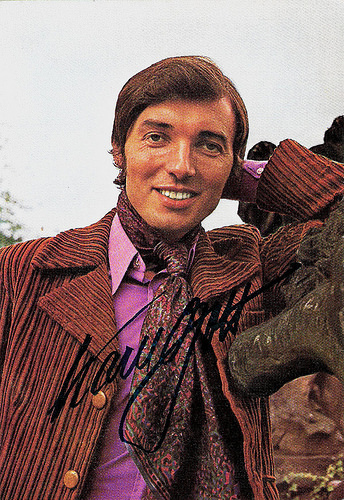
German promotion card by Polydor.
Eyes Covered by Snow
Karel Gott was born in 1939 in Pilsen, at that time Protectorate of Bohemia and Moravia, now Plzeň, Czech Republic, and has lived in Prague since age 6. He initially wanted to study art, but failed the exams at the School of Industrial Art, upon which he began training as an electrician.
On completing his studies, he began working as an electrician, but was soon fascinated by the new types of music flooding the city, and became interested in jazz. He experimented with playing the bass and the guitar, but eventually decided to focus on singing, studying it privately.
In 1958, he participated in the amateur singing contest Looking for New Talent in the Prague Slavonic House. He utterly failed to impress the judges, but soon made a name for himself in Prague jazz circles, finally getting his first engagement at the Vltava Prague Cafe that same year.
In 1960, he decided to undertake singing professionally. He studied opera at the Prague Conservatory under Konstantin Karenin, a student of the brilliant Russian bass Feodor Chaliapin. Knowing of Gott's interest in current musical trends, Karenin instructed him not only in classical Italian pieces, but also in the hits of the day. It was at this time that Gott travelled abroad (to Poland) for the first time with the Jazz Orchestra of the Czechoslovak Broadcast, conducted by Karel Krautgartner.
In 1962 or 1963 (the sources differ), Gott released his first single, Až nám bude dvakrát tolik (When we are twice as old), a duet with jazz singer Vlasta Průchová. Gott was voted into the Zlatý slavík (Golden Nightingale) viewer's survey, placing 49th and receiving a total of three votes.
His first solo single, Mesicni reka, the Czech version of Moon River became his breakthrough hit in 1962. In 1963 Gott was offered a place at the recently founded Prague Semafor theatre, which was then at the forefront of the emerging Czechoslovakian pop music scene. He released Oči sněhem zaváté (Eyes Covered by Snow), which became the year's best-selling record. Shortly afterwards, Gott received the first of his Zlatý slavík awards, given to the most popular artist of the year.
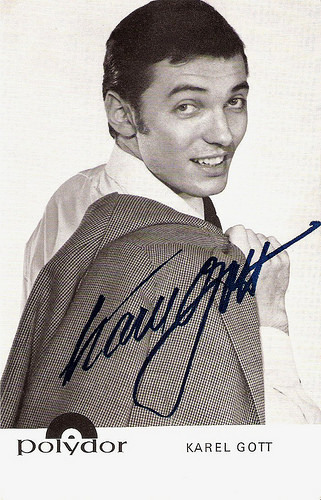
German promotion card by Polydor.
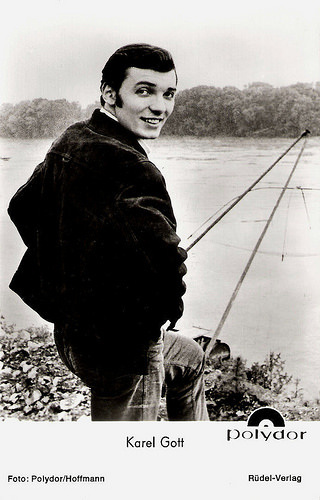
German postcard by Franz Josef Rüdel, Filmpostkartenverlag, Hamburg, no. 4909. Photo: Polydor / Hoffmann.
Maya the Honey Bee
In 1965, Karel Gott was a major star, appearing in the programs Pilgrimage for Two and Evening Prayer while building his own repertoire with his own orchestra. That year, he made his first film appearance in the musical Kdyby tisíc klarinetu/If a Thousand Clarinets (Ján Rohác, Vladimír Svitácek, 1965) with Jana Brejchová.
He also established the Apollo theatre, along with two brothers who were with him in Semafor: Jiří and Ladislav Štaidl. He began composing his own songs, and toured Czechoslovakia and abroad with the Apollo theatre.
His first album, Karel Gott Sings got great acclaim. This first album was followed by an English export album titled The Golden Voice of Prague. In 1967, Gott performed at MIDEM, the International Fair of Record Companies and Music Producers in Cannes, France, where the applause was measured during every concert. He surprised everyone by achieving a level of 54 to Tom Jones ' 58.
Following this event, Gott signed a contract with the Polydor / Deutsche Grammophon Gesellschaft record company, renewing it several times until it became a life contract in 1997. Between 1967 and 2000, Polydor released over 125 albums and 72 singles for Karel Gott in German speaking countries in Europe.
Films in which he appeared were Mucedníci lásky/Martyrs of Love (Jan Nemec, 1967) with British director Lindsay Anderson, and the German comedy Charley's Onkel/Charley’s Uncle (Werner Jacobs, 1969) featuring Gustav Knuth.
Gott represented Austria in the Eurovision Song Contest 1968 with the song Tausend Fenster, written by Udo Jürgens . He finished in 13th place. In the same year, Gott spent six months performing daily at the New Frontier Hotel and Casino in Las Vegas.
In the 1970s, domestic success was marked by Gott's presence on television, including the filming of a ten-part serial entitled Karel Gott in Slany. In 1971, after deciding not to return from a concert tour in West Germany to his home country, he was addressed a personal letter from the Czechoslovak party leader Gustav Husak persuading him to change his mind.
One of his most best-known pop hits was the title music to the Japanese anime series Maya the Honey Bee (1975). The original theme was composed by Karel Svoboda and sung by Karel Gott in the German, Czech and Slovak versions. In 1975 he also played the lead in the film musical Hvezda pada vzhuru/A Star Is Falling Upwards (Ladislav Rychman, 1975).
Karel Gott recorded a cover version of the song All by Myself called Kam tenkrát šel můj bratr Jan (Where Did My Brother Jan Go This Time). The song was dedicated to Jan Palach who set himself on fire and burned to death as a protest against Soviet occupation of Czechoslovakia in January 1969. According to Wikipedia , the song was recorded in 1977 while Soviet troops were still present in the country. In order to continue in his career, he had to sign in 1977 the so-called ‘Anti-charter’, a petition organized by the Communist government against the Charter 77 signed by Václav Havel and other dissidents, protesting the government's violations of the Helsinki Accords.
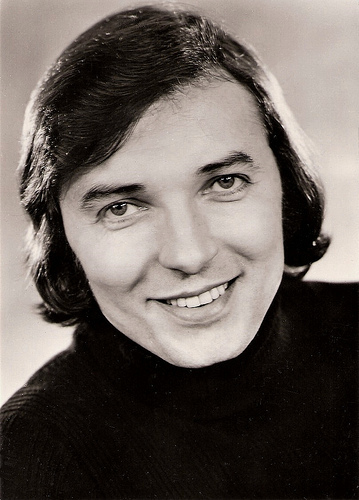
East-German postcard by Bild und Heimat, Reichenbach, no. G 6776, 1976. Photo: Leher, Berlin.
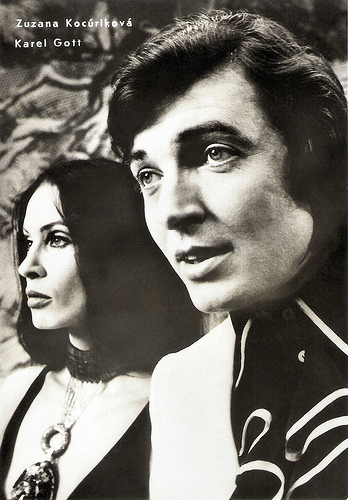
East-German postcard by Progress, Berlin, no. 33/76, 1976. Photo: publicity still for Hvezda pada vzhuru/A Star Is Falling Upwards (Ladislav Rychman, 1975) with Zuzana Kocúrlková.
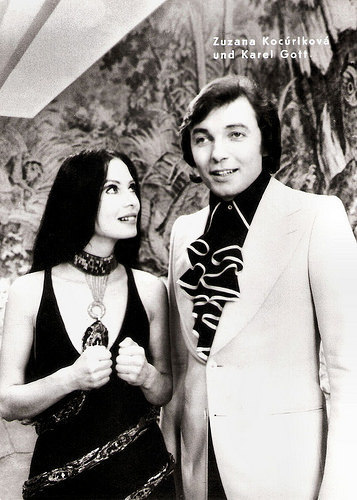
East-German postcard by Progress, Berlin, no. 41/76, 1976. Photo: publicity still for Hvezda pada vzhuru/A Star Is Falling Upwards (Ladislav Rychman, 1975) with Zuzana Kocúrlková.
His second great love
The 1980s were marked for Karel Gott by international success, including the filming in Italy of the musical In the Track of Bel Canto (1981), with a corresponding German-Italian album and duet performance with Sofia Rotaru in the Soviet Union. The following years, Gott received many awards, including The Supraphon Diamond Record Award, given him in 1992, for having sold 13 million records.
In 1990, he decided to end his career and arranged a huge farewell tour. However, the tour was so successful that he re-evaluated his decision. The 1990s were influenced by fundamental changes in the political system of the country, which were reflected in popular music, but it did not threaten his permanent position in the limelight of the domestic music scene. In 1991 a new television survey was created called TýTý. Karel Gott gained the first victory and at the same time became the outright winner of the survey.
In 1993, he established his own artistic agency, GOJA, with František Janeček. It is this agency that currently produces Gott's records and organizes his artistic activities. In 1996, following renewed public interest in his career, Gott again won 'The Golden Nightingale Award' with a huge lead over his rivals, and has retained the accolade many times since then.
Gott remains popular in a number of countries, including those of the former Soviet Union, where his first record, produced by Melodiya in 1977, sold a staggering 4.5 million copies. In 2000, he had his first concert in Carnegie Hall, New York.
During the 1990s, Gott began to focus increasingly on painting, his second great love. The first exhibition of his paintings took place in 1992, at the Prague Christ Child Gallery. He has since exhibited his work successfully in Berlin, Moscow, Munich, Cologne, Vienna, and Bratislava.
In 2001, he played the double role of Lucifer and God in the family comedy Z pekla stestí 2/Goblins and Good Luck 2 (Zdenek Troska, 2001). He also acts regularly in TV series.
Gott has two adult daughters (Dominika and Lucie) from former relationships (they have different mothers). He is also the father to Charlotte Ella with Ivana Macháčková whom he married on in 2008 in Las Vegas, the city where he started his international career. Their second daughter, Nelly Sofie, was born in summer 2008.
Compilation of early TV performances by Karel Gott. Source: Hit That Button (YouTube).
Karel Gott sings Kam tenkrát šel můj bratr Jan. Source: Benetomm (YouTube).
Sources: Jan Adam (KarelGott.com), Zuzana Drotárová (Gott.cz), Steve Leggett (AllMusic), Wikipedia (German and English) and .

German promotion card by Polydor, no. 49.

German promotion card by Polydor.
Eyes Covered by Snow
Karel Gott was born in 1939 in Pilsen, at that time Protectorate of Bohemia and Moravia, now Plzeň, Czech Republic, and has lived in Prague since age 6. He initially wanted to study art, but failed the exams at the School of Industrial Art, upon which he began training as an electrician.
On completing his studies, he began working as an electrician, but was soon fascinated by the new types of music flooding the city, and became interested in jazz. He experimented with playing the bass and the guitar, but eventually decided to focus on singing, studying it privately.
In 1958, he participated in the amateur singing contest Looking for New Talent in the Prague Slavonic House. He utterly failed to impress the judges, but soon made a name for himself in Prague jazz circles, finally getting his first engagement at the Vltava Prague Cafe that same year.
In 1960, he decided to undertake singing professionally. He studied opera at the Prague Conservatory under Konstantin Karenin, a student of the brilliant Russian bass Feodor Chaliapin. Knowing of Gott's interest in current musical trends, Karenin instructed him not only in classical Italian pieces, but also in the hits of the day. It was at this time that Gott travelled abroad (to Poland) for the first time with the Jazz Orchestra of the Czechoslovak Broadcast, conducted by Karel Krautgartner.
In 1962 or 1963 (the sources differ), Gott released his first single, Až nám bude dvakrát tolik (When we are twice as old), a duet with jazz singer Vlasta Průchová. Gott was voted into the Zlatý slavík (Golden Nightingale) viewer's survey, placing 49th and receiving a total of three votes.
His first solo single, Mesicni reka, the Czech version of Moon River became his breakthrough hit in 1962. In 1963 Gott was offered a place at the recently founded Prague Semafor theatre, which was then at the forefront of the emerging Czechoslovakian pop music scene. He released Oči sněhem zaváté (Eyes Covered by Snow), which became the year's best-selling record. Shortly afterwards, Gott received the first of his Zlatý slavík awards, given to the most popular artist of the year.

German promotion card by Polydor.

German postcard by Franz Josef Rüdel, Filmpostkartenverlag, Hamburg, no. 4909. Photo: Polydor / Hoffmann.
Maya the Honey Bee
In 1965, Karel Gott was a major star, appearing in the programs Pilgrimage for Two and Evening Prayer while building his own repertoire with his own orchestra. That year, he made his first film appearance in the musical Kdyby tisíc klarinetu/If a Thousand Clarinets (Ján Rohác, Vladimír Svitácek, 1965) with Jana Brejchová.
He also established the Apollo theatre, along with two brothers who were with him in Semafor: Jiří and Ladislav Štaidl. He began composing his own songs, and toured Czechoslovakia and abroad with the Apollo theatre.
His first album, Karel Gott Sings got great acclaim. This first album was followed by an English export album titled The Golden Voice of Prague. In 1967, Gott performed at MIDEM, the International Fair of Record Companies and Music Producers in Cannes, France, where the applause was measured during every concert. He surprised everyone by achieving a level of 54 to Tom Jones ' 58.
Following this event, Gott signed a contract with the Polydor / Deutsche Grammophon Gesellschaft record company, renewing it several times until it became a life contract in 1997. Between 1967 and 2000, Polydor released over 125 albums and 72 singles for Karel Gott in German speaking countries in Europe.
Films in which he appeared were Mucedníci lásky/Martyrs of Love (Jan Nemec, 1967) with British director Lindsay Anderson, and the German comedy Charley's Onkel/Charley’s Uncle (Werner Jacobs, 1969) featuring Gustav Knuth.
Gott represented Austria in the Eurovision Song Contest 1968 with the song Tausend Fenster, written by Udo Jürgens . He finished in 13th place. In the same year, Gott spent six months performing daily at the New Frontier Hotel and Casino in Las Vegas.
In the 1970s, domestic success was marked by Gott's presence on television, including the filming of a ten-part serial entitled Karel Gott in Slany. In 1971, after deciding not to return from a concert tour in West Germany to his home country, he was addressed a personal letter from the Czechoslovak party leader Gustav Husak persuading him to change his mind.
One of his most best-known pop hits was the title music to the Japanese anime series Maya the Honey Bee (1975). The original theme was composed by Karel Svoboda and sung by Karel Gott in the German, Czech and Slovak versions. In 1975 he also played the lead in the film musical Hvezda pada vzhuru/A Star Is Falling Upwards (Ladislav Rychman, 1975).
Karel Gott recorded a cover version of the song All by Myself called Kam tenkrát šel můj bratr Jan (Where Did My Brother Jan Go This Time). The song was dedicated to Jan Palach who set himself on fire and burned to death as a protest against Soviet occupation of Czechoslovakia in January 1969. According to Wikipedia , the song was recorded in 1977 while Soviet troops were still present in the country. In order to continue in his career, he had to sign in 1977 the so-called ‘Anti-charter’, a petition organized by the Communist government against the Charter 77 signed by Václav Havel and other dissidents, protesting the government's violations of the Helsinki Accords.

East-German postcard by Bild und Heimat, Reichenbach, no. G 6776, 1976. Photo: Leher, Berlin.

East-German postcard by Progress, Berlin, no. 33/76, 1976. Photo: publicity still for Hvezda pada vzhuru/A Star Is Falling Upwards (Ladislav Rychman, 1975) with Zuzana Kocúrlková.

East-German postcard by Progress, Berlin, no. 41/76, 1976. Photo: publicity still for Hvezda pada vzhuru/A Star Is Falling Upwards (Ladislav Rychman, 1975) with Zuzana Kocúrlková.
His second great love
The 1980s were marked for Karel Gott by international success, including the filming in Italy of the musical In the Track of Bel Canto (1981), with a corresponding German-Italian album and duet performance with Sofia Rotaru in the Soviet Union. The following years, Gott received many awards, including The Supraphon Diamond Record Award, given him in 1992, for having sold 13 million records.
In 1990, he decided to end his career and arranged a huge farewell tour. However, the tour was so successful that he re-evaluated his decision. The 1990s were influenced by fundamental changes in the political system of the country, which were reflected in popular music, but it did not threaten his permanent position in the limelight of the domestic music scene. In 1991 a new television survey was created called TýTý. Karel Gott gained the first victory and at the same time became the outright winner of the survey.
In 1993, he established his own artistic agency, GOJA, with František Janeček. It is this agency that currently produces Gott's records and organizes his artistic activities. In 1996, following renewed public interest in his career, Gott again won 'The Golden Nightingale Award' with a huge lead over his rivals, and has retained the accolade many times since then.
Gott remains popular in a number of countries, including those of the former Soviet Union, where his first record, produced by Melodiya in 1977, sold a staggering 4.5 million copies. In 2000, he had his first concert in Carnegie Hall, New York.
During the 1990s, Gott began to focus increasingly on painting, his second great love. The first exhibition of his paintings took place in 1992, at the Prague Christ Child Gallery. He has since exhibited his work successfully in Berlin, Moscow, Munich, Cologne, Vienna, and Bratislava.
In 2001, he played the double role of Lucifer and God in the family comedy Z pekla stestí 2/Goblins and Good Luck 2 (Zdenek Troska, 2001). He also acts regularly in TV series.
Gott has two adult daughters (Dominika and Lucie) from former relationships (they have different mothers). He is also the father to Charlotte Ella with Ivana Macháčková whom he married on in 2008 in Las Vegas, the city where he started his international career. Their second daughter, Nelly Sofie, was born in summer 2008.
Compilation of early TV performances by Karel Gott. Source: Hit That Button (YouTube).
Karel Gott sings Kam tenkrát šel můj bratr Jan. Source: Benetomm (YouTube).
Sources: Jan Adam (KarelGott.com), Zuzana Drotárová (Gott.cz), Steve Leggett (AllMusic), Wikipedia (German and English) and .
Published on November 11, 2014 23:00
November 10, 2014
Alphons Fryland
Austrian film actor Alphons Fryland (1888-1953) appeared in 47 Austrian and German films between 1921 and 1933. Sound film finished his career.
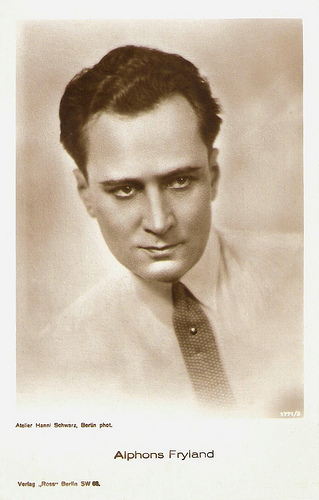
German postcard by Ross Verlag, Berlin, no. 1771/3, 1927-1928. Photo: Hanni Schwarz, Berlin.
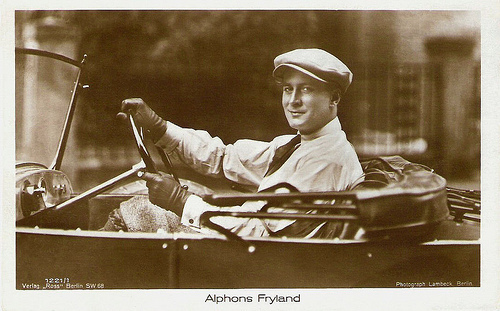
German postcard by Ross Verlag, Berlin, no. 1221/1, 1927-1928. Photo: Lambeck, Berlin.
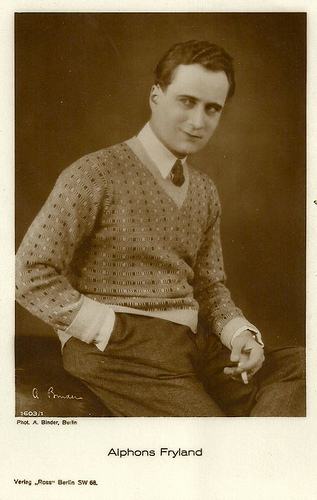
German postcard by Ross Verlag, no. 1603/1,1927-1928. Photo: Alex Binder, Berlin.
Comet-like Career
Alphons (or Alfons) Fryland was born as Alphons Fritsch in Vienna, Austria-Hungary (now Austria), in 1888.
He attended the Exportakademie Wien. From 1914 on he studied music in Graz, München and Paris. He then followed acting classes from Karl Peppler, but during World War I he had to serve in the army.
In 1919, he was engaged by director Fritz Freisler as the leading actor of the film Jagd nach dem Glück/Hunt For Happiness (Fritz Freisler, 1920), produced by Sascha-Film.
He then made a comet-like career in the Austrian and German cinema. In 1921 Fryland starred in four films opposite Hungarian star Lucy Doraine . All four were directed by Doraine's husband Mihály Kertész later better known as Michael Curtiz: Labyrinth des Grauens/Labyrinth of Horror (1921) in which he played a serial killer, Frau Dorothys Bekenntnis/Mrs. Dane's Confession (1921), Herzogin Satanella/Good and Evil (1921) and Mrs. Tutti Frutti (1921).
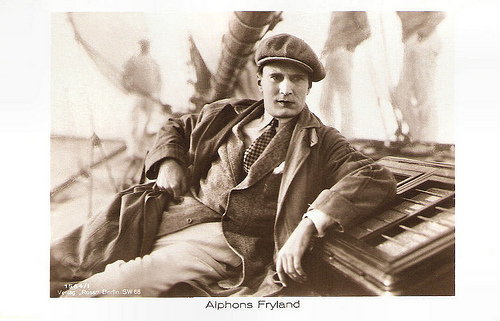
German postcard by Ross Verlag, Berlin, no. 1564/1, 1927-1928.
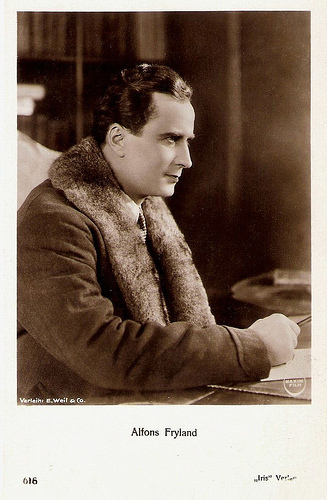
Austrian postcard by Iris-Verlag, no. 616. Photo: Verleih B. Weil & Co.
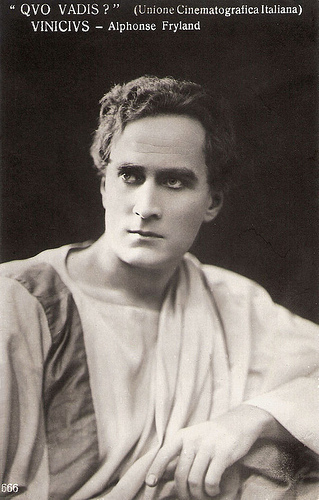
Italian postcard by Ed. Romeo Biagi, Bologna, no. 666. Photo: Unione Cinematografica Italiana. Publicity still for Quo vadis? (Gabriellino D'Annunzio, Georg Jacoby, 1925).
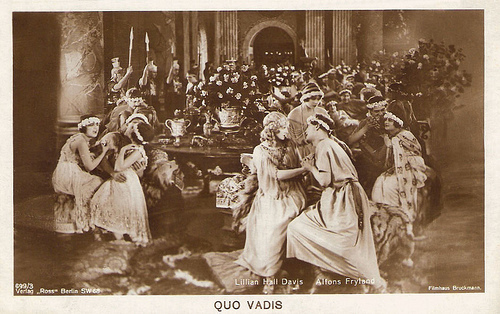
German postcard by Ross Verlag, no. 699/3, 1919-1924. Photo: Filmhaus Bruckmann. Publicity still for Quo vadis? (Gabriellino D'Annunzio, Georg Jacoby, 1925) with Alphons Fryland and Lilian Hall-Davis .
Super Production
Alphons Fryland played both leads and supporting roles in many German and Austrian films of the 1920s and he became quite popular.
His co-star in these silent films was often Liane Haid in such films as the blockbuster Lucrezia Borgia/Lucretia Borgia (Richard Oswald, 1922), and Ich liebe dich/I Love You (Paul L. Stein, 1925).
Among his other popular films were Kean (Rudolf Biebrach, 1921) starring Alexander Moissi , Zwischen Abend und Morgen/Between Evening and Morning (Arthur Robison, 1923) with Werner Krauss , and Arabella (Karl Grune, 1924) with Mae Marsh.
A super production was the German-Italian epic Quo Vadis? (Gabriellino D'Annunzio, Georg Jacoby, 1925) based on the novel by Nobel prize winner Henryk Sienkiewicz. Fryland played the rather fey hero Vinicius, and he was completely overwhelmed by the other star, the great Emil Jannings as the infamous emperor Nero.
Another big production was Das schicksal derer von Habsburg/The Desiny of the Habsburgs (1928) a dramatic account of the Austrian royal family at the turn of the 20th century. Fryland starred as Sissi's son, Crown Prince Rudolf who committed suicide toggether with his young - and pregnant - mistress, the beautiful baroness Marie Vetsera. He was surrounded by an all-star cast including Erna Morena as empress Sissi, Maly Delschaft as Rudolph's wife, the Belgium's princess Stéphanie and Leni Riefenstahl as Vetsera.
Towards the end of the 1920s his career slowly went into decline. The sound revolution finished his career.
He appeared only in a few sound films: the mountain drama Der Bergführer von Zakopane/The Mountain Guide of Zakopane (Domenico Gambino, Adolf Trotz, 1931), and Die Nacht der Entscheidung/The Night of the Decision (Dimitri Buchowetzki, 1931) with Conrad Veidt .
In 1932 he became a NSDAP party member, and he claimed to be discriminated for film parts by the Jewish producer Alfred Zeisler. It didn't help to further his career. He made one last film, Johannisnacht/Midsummer Night (Willy Reiber, 1933) starring Lil Dagover .
After these uninteresting roles, he retired and returned to Graz. There he called himself Alphons Fritsch again. He worked as a consultant at the administrative district office.
Forgotten, Alphons Fryland died in Graz, Austria in 1953, aged 65.
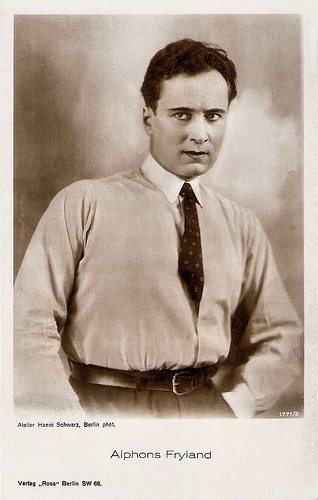
German postcard by Ross Verlag, no. 1771/2, 1927-1928. Photo: Atelier Hanni Schwarz, Berlin.
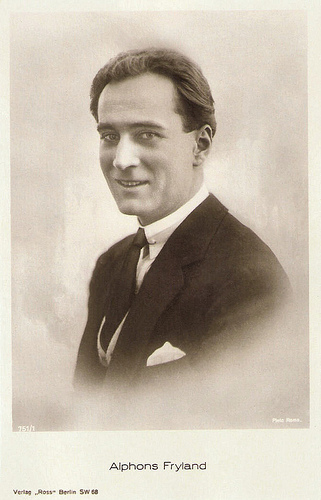
German postcard by Ross Verlag, no. 751/1, 1925-1926. Photo: Roma.
Sources: Thomas Staedeli (Cyranos - German), Philippe Pelletier (CinéArtistes - French), Nicole Gagne (AllMovie), Wikipedia, and .

German postcard by Ross Verlag, Berlin, no. 1771/3, 1927-1928. Photo: Hanni Schwarz, Berlin.

German postcard by Ross Verlag, Berlin, no. 1221/1, 1927-1928. Photo: Lambeck, Berlin.

German postcard by Ross Verlag, no. 1603/1,1927-1928. Photo: Alex Binder, Berlin.
Comet-like Career
Alphons (or Alfons) Fryland was born as Alphons Fritsch in Vienna, Austria-Hungary (now Austria), in 1888.
He attended the Exportakademie Wien. From 1914 on he studied music in Graz, München and Paris. He then followed acting classes from Karl Peppler, but during World War I he had to serve in the army.
In 1919, he was engaged by director Fritz Freisler as the leading actor of the film Jagd nach dem Glück/Hunt For Happiness (Fritz Freisler, 1920), produced by Sascha-Film.
He then made a comet-like career in the Austrian and German cinema. In 1921 Fryland starred in four films opposite Hungarian star Lucy Doraine . All four were directed by Doraine's husband Mihály Kertész later better known as Michael Curtiz: Labyrinth des Grauens/Labyrinth of Horror (1921) in which he played a serial killer, Frau Dorothys Bekenntnis/Mrs. Dane's Confession (1921), Herzogin Satanella/Good and Evil (1921) and Mrs. Tutti Frutti (1921).

German postcard by Ross Verlag, Berlin, no. 1564/1, 1927-1928.

Austrian postcard by Iris-Verlag, no. 616. Photo: Verleih B. Weil & Co.

Italian postcard by Ed. Romeo Biagi, Bologna, no. 666. Photo: Unione Cinematografica Italiana. Publicity still for Quo vadis? (Gabriellino D'Annunzio, Georg Jacoby, 1925).

German postcard by Ross Verlag, no. 699/3, 1919-1924. Photo: Filmhaus Bruckmann. Publicity still for Quo vadis? (Gabriellino D'Annunzio, Georg Jacoby, 1925) with Alphons Fryland and Lilian Hall-Davis .
Super Production
Alphons Fryland played both leads and supporting roles in many German and Austrian films of the 1920s and he became quite popular.
His co-star in these silent films was often Liane Haid in such films as the blockbuster Lucrezia Borgia/Lucretia Borgia (Richard Oswald, 1922), and Ich liebe dich/I Love You (Paul L. Stein, 1925).
Among his other popular films were Kean (Rudolf Biebrach, 1921) starring Alexander Moissi , Zwischen Abend und Morgen/Between Evening and Morning (Arthur Robison, 1923) with Werner Krauss , and Arabella (Karl Grune, 1924) with Mae Marsh.
A super production was the German-Italian epic Quo Vadis? (Gabriellino D'Annunzio, Georg Jacoby, 1925) based on the novel by Nobel prize winner Henryk Sienkiewicz. Fryland played the rather fey hero Vinicius, and he was completely overwhelmed by the other star, the great Emil Jannings as the infamous emperor Nero.
Another big production was Das schicksal derer von Habsburg/The Desiny of the Habsburgs (1928) a dramatic account of the Austrian royal family at the turn of the 20th century. Fryland starred as Sissi's son, Crown Prince Rudolf who committed suicide toggether with his young - and pregnant - mistress, the beautiful baroness Marie Vetsera. He was surrounded by an all-star cast including Erna Morena as empress Sissi, Maly Delschaft as Rudolph's wife, the Belgium's princess Stéphanie and Leni Riefenstahl as Vetsera.
Towards the end of the 1920s his career slowly went into decline. The sound revolution finished his career.
He appeared only in a few sound films: the mountain drama Der Bergführer von Zakopane/The Mountain Guide of Zakopane (Domenico Gambino, Adolf Trotz, 1931), and Die Nacht der Entscheidung/The Night of the Decision (Dimitri Buchowetzki, 1931) with Conrad Veidt .
In 1932 he became a NSDAP party member, and he claimed to be discriminated for film parts by the Jewish producer Alfred Zeisler. It didn't help to further his career. He made one last film, Johannisnacht/Midsummer Night (Willy Reiber, 1933) starring Lil Dagover .
After these uninteresting roles, he retired and returned to Graz. There he called himself Alphons Fritsch again. He worked as a consultant at the administrative district office.
Forgotten, Alphons Fryland died in Graz, Austria in 1953, aged 65.

German postcard by Ross Verlag, no. 1771/2, 1927-1928. Photo: Atelier Hanni Schwarz, Berlin.

German postcard by Ross Verlag, no. 751/1, 1925-1926. Photo: Roma.
Sources: Thomas Staedeli (Cyranos - German), Philippe Pelletier (CinéArtistes - French), Nicole Gagne (AllMovie), Wikipedia, and .
Published on November 10, 2014 23:00
November 9, 2014
The Choice of Jan-Hein Bal
Today, my former colleague Jan-Hein Bal takes leave as the stills librarian of EYE Film Institute in Amsterdam due to retirement. For 41 years, Jan-Hein worked for The Netherlands Filmmuseum and later for EYE. So for this special occasion, we 're-issue' a post with his favourite film postcards in the series The Choice of....
Jan-Hein Bal: "I'm no film collector, only of information on subjects like Saul Bass, 70mm, Amsterdam cinema buildings etc. My largest collection are memories of thousands of movies I saw. I am Amsterdam EYE Filmmuseum stills librarian with over half a million stills, including tens of thousands of postcards, mostly published by Ross. About 1500 are digitized including 500 portraits but further scans are only produced on request and visible in our library only. This selection includes no portraits but a very different choice." Double click at the pictures to see them in full view.

Bambi. Dutch postcard by Rembrandt Uitg. Mij. Amsterdam. Publicity still for Bambi (James Agar e.a., 1942). Caption: "Hij kan warempel al lopen! roept konijn Stamper" ("He can even walk already! shouts rabbit Stamper").
Jan-Hein Bal: "One of several Dutch postcards from Bambi, my first cinema experience in 1957 aged eight. I always vividly remembered Bambi on ice, the realistic forest fire and the impressive scenery, unequalled until The Lion King. Half a century later on second viewing, I was excited by the multi plane camera depth effect."
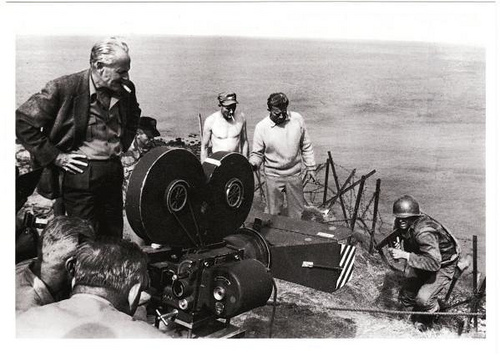
The Longest Day. German postcard by Filmwelt Berlin, Bakede, no. 56574, 1994 (reprint). Photo: Sam Shaw, News Productions, Baulmes-Stroud. Caption: "THE LONGEST DAY, Dar[r]yl Zanuck, Normandie, 1964".
"I am in charge of the Amsterdam EYE Filmmuseum's stills collection and love location shots with filmmakers, like this postcard reproduction with producer Zanuck and CinemaScope camera circa 1962 (not 1964) at Pointe du Hoc in Normandy. Sam Shaw was only a visitor as Vincent Rossell was stills photographer. This was in 1963 my first widescreen cinema experience and is half a century later still my favorite black-and-widescreen film, with its exciting aerial and tracking shots. Curiously this best-bw-photography-Oscar winner was colorized later and long unavailable in bw until the DVD. I visited several French locations, saw its composer Maurice Jarre and actress Irina Demick at festivals and interviewed its actor Arnold Gelderman (German soldier opposite Demick)."
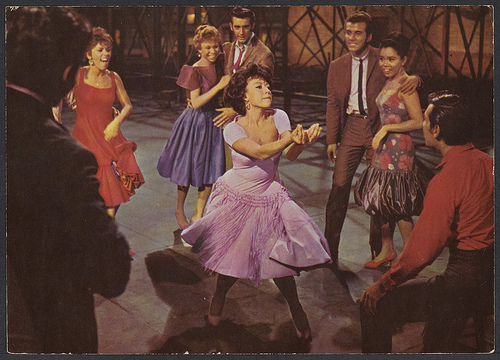
Rita Moreno in West Side Story. Dutch postcard. Photo: publicity still of West Side Story (Robert Wise, 1961). Collection: Amsterdam EYE Filmmuseum.
"One of several large size A5 postcards from my favorite musical with its impressive music, ballet, design and social issues. No quick cuts and no nervous camera movements but dancers performing their exciting choreography in long shots and long takes. Besides Bridge on the River Kwai I saw it more often than anything else but never watch my DVD as it is the only film from my youth which was always in distribution. Thanks to the Amsterdam EYE Filmmuseum it can be seen on 70mm again."
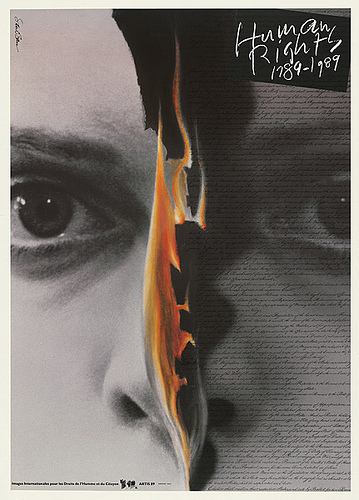
Human Rights 1789-1989. Dutch postcard by Art Unlimited, Amsterdam, no. A277. Poster design: Saul Bass.
"I always admired Saul Bass for his brilliant movie title sequences and already visited the Amsterdam Filmmuseum's retrospective in 1969. When I later became involved in the museum's poster collection his printed art added a whole new dimension and I bought many of his vintage posters for their already impressive but uneven collection. This postcard reproduction shows one of his Human Rights poster designs. Not film related? Wrong, because Bass secretly used it again from his own 1956 poster for the Bette Davis movie Storm Center."
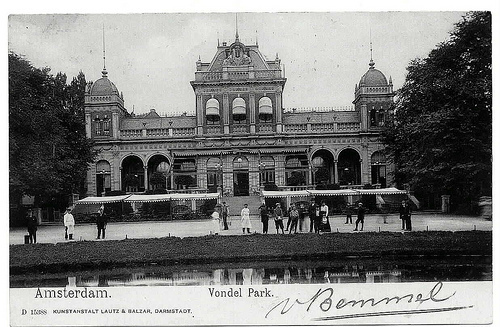
Amsterdam Vondelpark. German postcard by Kunstanstalt Lautz & Balzar, Darmstadt, no. D15388. Sent by mail in 1905.
"This Amsterdam Vondelpark renaissance palace from 1881, seen on countless vintage postcards like this, was Filmmuseum between 1974 and 2012, almost identical to my long career. Here I discovered Die Nibelungen and Metropolis etc. in total silence because it was not yet fully understood that silents too had music. Many architectural details disappeared long ago but the building's middle stairs will return during its change as a broadcasting studio after 2013."
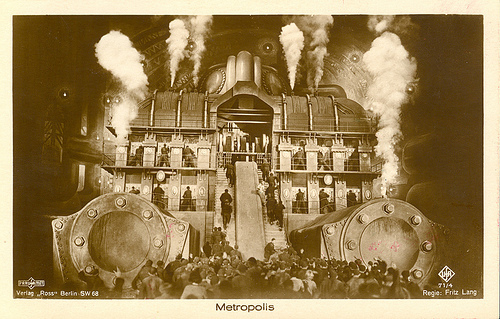
Metropolis. German postcard by Ross Verlag, Berlin, no. 71-4. Photo: Ufa. Publicity still for Metropolis (Fritz Lang, 1927).
"One of several Ross postcards from my favorite Fritz Lang movie, favorite silent SF, and favorite silent movie design, with the incredible Babel sequence, flood, tunnels, skyscrapers, factory, laboratory etc."
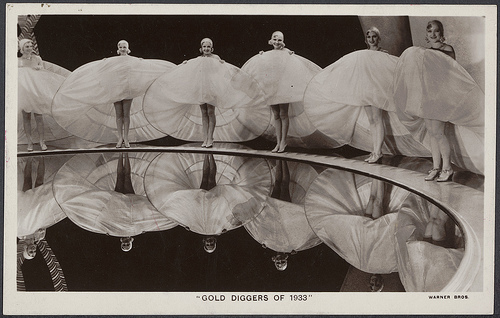
Gold Diggers of 1933. Dutch postcard by M. Bonnist & Zonen Amsterdam. Photo: Warner Bros. Publicity still for Golddiggers of 1933 (Mervyn Leroy, 1933).
"One of several Dutch postcards from this musical. Besides design I also love dance sequences like those of Astaire-Rogers, Gene Kelly, Bollywood, The Red Shoes, Saura's Carmen, White Nights, Billy Elliot, Mao's Last Dancer etc. Busby Berkeley's choreographies like this postcard are almost a combination of dance and design."

Cinerama. American postcard by Shorecolor New York, circa 1952.
"Many decades I only knew Cinerama from my favorite Amsterdam Bellevue Cinerama 70mm cinema but in 2011 I finally experienced 3-strip projection at the Bradford widescreenfestival with This is Cinerama, seen on this vintage postcard. The closure of the Bellevue cinema in Amsterdam in 2005 triggered my Amsterdam 70mm cinema history website 70mm.nl and I even became a cinema projectionist during the final 35mm years."
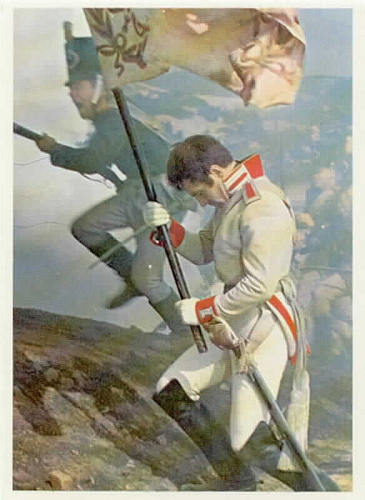
War and Peace. Russian postcard by Sovexportfilm. Publicity still for Voyna i mir/War and Peace (Sergei Bondarchuk, 1965-1966). Caption: "VOINA I MIR, WAR AND PEACE, GUERRE ET PAIX, GUERRA Y PAZ".
"Since a festival in an East Berlin cinema I investigate Soviet widescreen history, including the world's largest and most successful 70mm production which continued until 1989. This is one of several postcards from their most ambitious 70mm film. The dance, fire and battle scenes have many impressive tracking shots and giant crane shots."
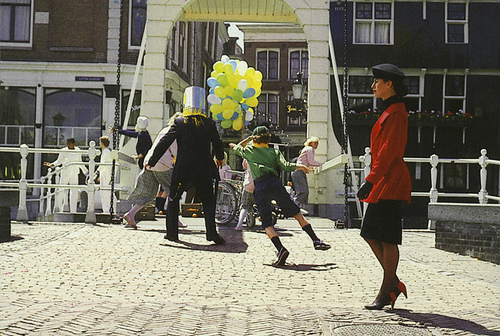
Femme Fatale. Caption: "FEMME FATALE, een film van Inge Calame van Alphen". Photo: Ecco Productie, Orlow Seunke.
"This is my favorite Dutch short fiction film, a sound movie from 1987 without dialogue and resembling silent slapsticks with Buster Keaton, Harold Lloyd etc. It was shot in my home town Alkmaar seen on this postcard, and as a projectionist I was allowed by producer Orlow Seunke a private 35mm screening for a scouting group during an excursion to my Alkmaar arthouse cinema."
All the postcards in this post are from the collection of EYE. Watch the Vondelpark postcard closely: during the 1980s, Jan-Hein used to work in the library at the left part of the Filmmuseum on the ground floor, I worked under the centre roof at the poster collection. Jan-Hein, thanks for all the good work you did all these years and enjoy your party today. Cheers!
Jan-Hein Bal: "I'm no film collector, only of information on subjects like Saul Bass, 70mm, Amsterdam cinema buildings etc. My largest collection are memories of thousands of movies I saw. I am Amsterdam EYE Filmmuseum stills librarian with over half a million stills, including tens of thousands of postcards, mostly published by Ross. About 1500 are digitized including 500 portraits but further scans are only produced on request and visible in our library only. This selection includes no portraits but a very different choice." Double click at the pictures to see them in full view.

Bambi. Dutch postcard by Rembrandt Uitg. Mij. Amsterdam. Publicity still for Bambi (James Agar e.a., 1942). Caption: "Hij kan warempel al lopen! roept konijn Stamper" ("He can even walk already! shouts rabbit Stamper").
Jan-Hein Bal: "One of several Dutch postcards from Bambi, my first cinema experience in 1957 aged eight. I always vividly remembered Bambi on ice, the realistic forest fire and the impressive scenery, unequalled until The Lion King. Half a century later on second viewing, I was excited by the multi plane camera depth effect."

The Longest Day. German postcard by Filmwelt Berlin, Bakede, no. 56574, 1994 (reprint). Photo: Sam Shaw, News Productions, Baulmes-Stroud. Caption: "THE LONGEST DAY, Dar[r]yl Zanuck, Normandie, 1964".
"I am in charge of the Amsterdam EYE Filmmuseum's stills collection and love location shots with filmmakers, like this postcard reproduction with producer Zanuck and CinemaScope camera circa 1962 (not 1964) at Pointe du Hoc in Normandy. Sam Shaw was only a visitor as Vincent Rossell was stills photographer. This was in 1963 my first widescreen cinema experience and is half a century later still my favorite black-and-widescreen film, with its exciting aerial and tracking shots. Curiously this best-bw-photography-Oscar winner was colorized later and long unavailable in bw until the DVD. I visited several French locations, saw its composer Maurice Jarre and actress Irina Demick at festivals and interviewed its actor Arnold Gelderman (German soldier opposite Demick)."

Rita Moreno in West Side Story. Dutch postcard. Photo: publicity still of West Side Story (Robert Wise, 1961). Collection: Amsterdam EYE Filmmuseum.
"One of several large size A5 postcards from my favorite musical with its impressive music, ballet, design and social issues. No quick cuts and no nervous camera movements but dancers performing their exciting choreography in long shots and long takes. Besides Bridge on the River Kwai I saw it more often than anything else but never watch my DVD as it is the only film from my youth which was always in distribution. Thanks to the Amsterdam EYE Filmmuseum it can be seen on 70mm again."

Human Rights 1789-1989. Dutch postcard by Art Unlimited, Amsterdam, no. A277. Poster design: Saul Bass.
"I always admired Saul Bass for his brilliant movie title sequences and already visited the Amsterdam Filmmuseum's retrospective in 1969. When I later became involved in the museum's poster collection his printed art added a whole new dimension and I bought many of his vintage posters for their already impressive but uneven collection. This postcard reproduction shows one of his Human Rights poster designs. Not film related? Wrong, because Bass secretly used it again from his own 1956 poster for the Bette Davis movie Storm Center."

Amsterdam Vondelpark. German postcard by Kunstanstalt Lautz & Balzar, Darmstadt, no. D15388. Sent by mail in 1905.
"This Amsterdam Vondelpark renaissance palace from 1881, seen on countless vintage postcards like this, was Filmmuseum between 1974 and 2012, almost identical to my long career. Here I discovered Die Nibelungen and Metropolis etc. in total silence because it was not yet fully understood that silents too had music. Many architectural details disappeared long ago but the building's middle stairs will return during its change as a broadcasting studio after 2013."

Metropolis. German postcard by Ross Verlag, Berlin, no. 71-4. Photo: Ufa. Publicity still for Metropolis (Fritz Lang, 1927).
"One of several Ross postcards from my favorite Fritz Lang movie, favorite silent SF, and favorite silent movie design, with the incredible Babel sequence, flood, tunnels, skyscrapers, factory, laboratory etc."

Gold Diggers of 1933. Dutch postcard by M. Bonnist & Zonen Amsterdam. Photo: Warner Bros. Publicity still for Golddiggers of 1933 (Mervyn Leroy, 1933).
"One of several Dutch postcards from this musical. Besides design I also love dance sequences like those of Astaire-Rogers, Gene Kelly, Bollywood, The Red Shoes, Saura's Carmen, White Nights, Billy Elliot, Mao's Last Dancer etc. Busby Berkeley's choreographies like this postcard are almost a combination of dance and design."

Cinerama. American postcard by Shorecolor New York, circa 1952.
"Many decades I only knew Cinerama from my favorite Amsterdam Bellevue Cinerama 70mm cinema but in 2011 I finally experienced 3-strip projection at the Bradford widescreenfestival with This is Cinerama, seen on this vintage postcard. The closure of the Bellevue cinema in Amsterdam in 2005 triggered my Amsterdam 70mm cinema history website 70mm.nl and I even became a cinema projectionist during the final 35mm years."

War and Peace. Russian postcard by Sovexportfilm. Publicity still for Voyna i mir/War and Peace (Sergei Bondarchuk, 1965-1966). Caption: "VOINA I MIR, WAR AND PEACE, GUERRE ET PAIX, GUERRA Y PAZ".
"Since a festival in an East Berlin cinema I investigate Soviet widescreen history, including the world's largest and most successful 70mm production which continued until 1989. This is one of several postcards from their most ambitious 70mm film. The dance, fire and battle scenes have many impressive tracking shots and giant crane shots."

Femme Fatale. Caption: "FEMME FATALE, een film van Inge Calame van Alphen". Photo: Ecco Productie, Orlow Seunke.
"This is my favorite Dutch short fiction film, a sound movie from 1987 without dialogue and resembling silent slapsticks with Buster Keaton, Harold Lloyd etc. It was shot in my home town Alkmaar seen on this postcard, and as a projectionist I was allowed by producer Orlow Seunke a private 35mm screening for a scouting group during an excursion to my Alkmaar arthouse cinema."
All the postcards in this post are from the collection of EYE. Watch the Vondelpark postcard closely: during the 1980s, Jan-Hein used to work in the library at the left part of the Filmmuseum on the ground floor, I worked under the centre roof at the poster collection. Jan-Hein, thanks for all the good work you did all these years and enjoy your party today. Cheers!
Published on November 09, 2014 23:00
Vico Torriani
Swiss Schlagersinger and actor Vico Torriani (1920-1998) was also a popular TV showmaster and an author of cookbooks. In the 1950s and early 1960s, he starred in a dozen German film musicals and comedies. The favourite Son of Switzerland sold more than twenty million records.
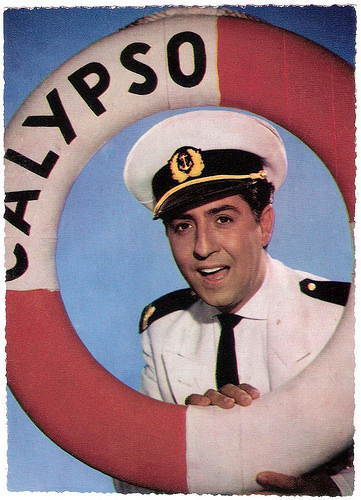
German postcard by Franz Josef Rüdel Filmpostkartenverlag, Hamburg-Bergedorf, no. FT-31. Photo: Zeyn Film / Deutsche Film Hansa / Lilo. Publicity still for Träume von der Südsee/Dreams of the South Seas (Harald Philipp, 1957).
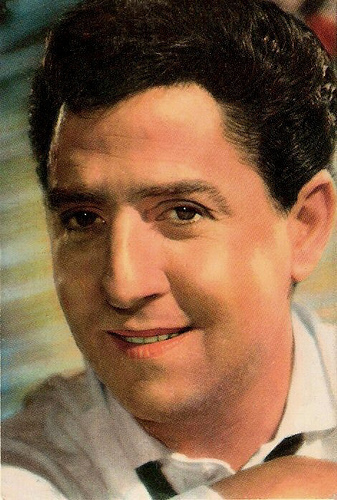
Belgian Collector's card, no. 71.
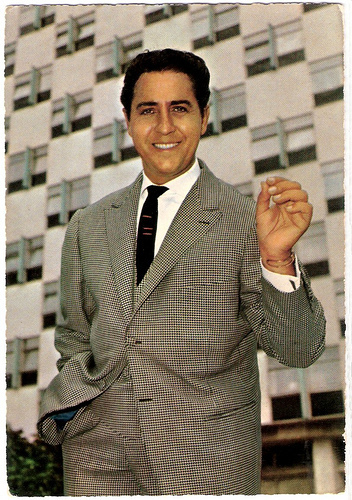
German postcard by Krüger, no. 902/52. Photo: Teldec / Bulanda.
A Heart Full of Music
Ludovico Oxens (Vico) Torriani was born in Genève (Geneva), Switzerland, in 1920. He was the son of Italian Vittorio Torriani, a riding and ski instructor, and his wife Clara Helena, born Bensegger.
Vico grew up in St. Moritz and after finishing school he studied for pastry cook, cook and later for waiter. As a 15 year old he already gave concerts. As a soldier during WW II he learned himself to play the guitar and the accordion.
In 1945 (some sources say 1946) he won a talent contest and he started singing on the Swiss radio and in night clubs everywhere in Europe. His first hit in Switzerland was Silberfäden (Silver Threads) in 1949.
In 1951 followed his first big success in Germany with Addio, donna grazia. From then on he recorded many records in English, French, Italian and German (and even in Retoroman).
In the 1950s he was seen in several Schlagerfilms and other film musicals. Among his most popular films were the ice skating film Der bunte Traum/The Colourful Dream (Géza von Cziffra, 1952) with Vera Molnar , Gitarren der Liebe/Guitars of Love(Werner Jacobs, 1954), Ein Herz voll Musik/A Heart Full of Music (Robert A. Stemmle, 1955) – his first leading role, Santa Lucia (Werner Jacob, 1956s) with Eva Kerbler and Karin Dor , and Der Stern von Santa Clara/The Star of Santa Clara (Werner Jacobs, 1958).
From 1952 on he also appeared on television. In 1958 he was a contestant for the German song contest, but never reached the Eurovision Song Contest. From 1959 on he got his own shows, first in Switzerland and later in Germany for example Grüezi, Vico, Hotel Victoria and the Vico-Torriani-Show.
Torriani also sang and played on stage in operettas and musicals during the 1950s and 1960s.
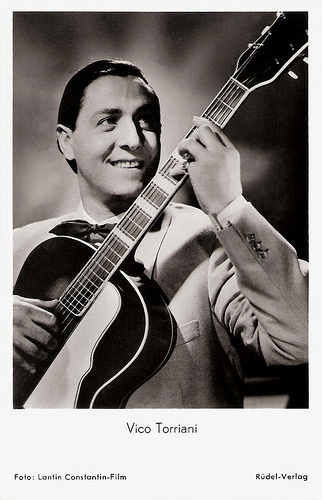
German postcard by F.J. Rüdel, Filmpostkartenverlag, Hamburg-Bergedorf, no. 549. Photo: Lantin / Constantin-Film. Meine Frau macht Dummheiten/My Wife is Acting Silly (Géza von Bolváry, 1952).
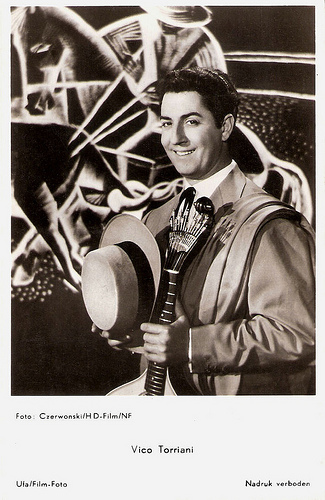
Belgian postcard by DRC Holland, no. 3500. Licency holder for Ufa. Photo: Czerwonski / HD-Film / NF.
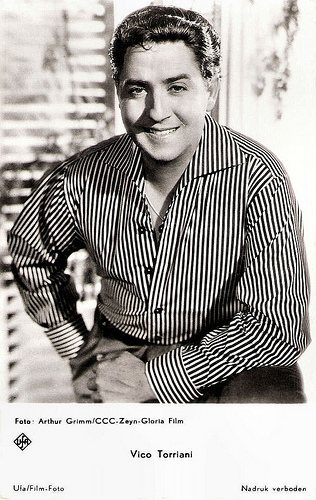
Dutch postcard by Gebr. Spanjersberg N.V., Rotterdam, no. 3700. Dutch licency holder for Ufa. Photo: Arthur Grimm / CCC-Zeyn / Gloria Film.
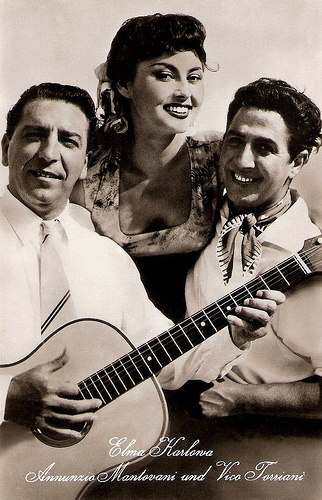
East-German postcard by Progress Vertrieb, Berlin, no. 282, 1957. Photo: Neue Emelka / Willy-Zeyn-Produktion. Publicity still for Gitarren der Liebe/Guitars of Love (Werner Jacobs, 1954) with Annunzio Montovani and Elma Karlowa .
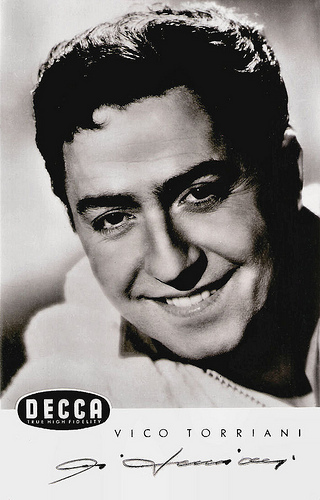
German postcard by Teldec Telefunken-Decca Schallplatten G.m.b.H. Photo: Teldeck / Zeyn Film / DFH / Lilo.
O sole mio
In the early 1960s, Vico Torriani starred in more German entertainment films like O sole mio (Paul Martin, 1960) with Senta Berger , and Robert und Bertram/Robert and Bertram (Hans Deppe, 1961) with comedian Willy Millowitsch.
In 1964 his career as a film actor and a recording artist was finished. From 1967 till 1970 he worked as a showmaster on German television.
In the 1970s he made a successful come-back as a singer of folk songs. His La Pastorella was a big hit in 1976. In 1977 he reappeared as an actor now on TV in the Krimi series Tatort starring Hansjörg Felmy .
Between 1978 and 1983 Torriani again hosted a restaurant in Basel, but meanwhile he also kept touring as a singer. In 1982 his song Caprifischer (Fishermen of Capri) became the winner of the TV show Die schönsten Melodien der Welt (The Most Beautiful Melodies in the World).
In 1995 he was awarded the Bambi Lifetime-Award together with Caterina Valente and Helmut Zacharias. He kept making guest-appearances on TV shows till the end of his life.
Vico Torriani died from cancer in 1998 in his home in Agno (Tessin), Switzerland. He and his wife Evelyne had a daughter, Nicole, and a son, Reto.
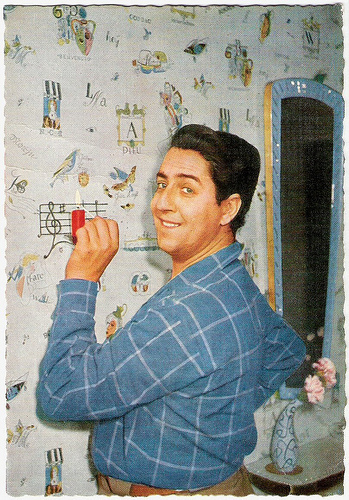
German postcard by WS-Druck, Wanne-Eickel, no. F 22.Photo: Ringpress.
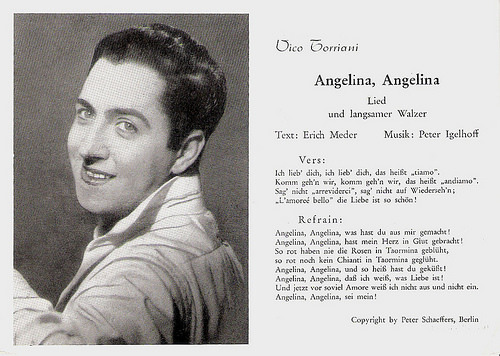
German postcard by Schumann-Verlag, Berlin. Photo: Peter Schaeffers (Schaeffers-Archiv).
Vico Torriani sings Antonella in Der Stern von Santa Clara (Werner Jacobs, 1958) with Gerlinde Locker. Source:Fritz51265 (YouTube).
Vico Torriani sings Jedes Mädchen hat seinen Amigo in Der Stern von Santa Clara (Werner Jacobs, 1958). Source: Fritz51265 (YouTube).
Sources: Stephanie D'heil (Steffi-line - German), Gabriela Schöb (Historisches Lexikon der Schweiz - German), Wikipedia (German), and .

German postcard by Franz Josef Rüdel Filmpostkartenverlag, Hamburg-Bergedorf, no. FT-31. Photo: Zeyn Film / Deutsche Film Hansa / Lilo. Publicity still for Träume von der Südsee/Dreams of the South Seas (Harald Philipp, 1957).

Belgian Collector's card, no. 71.

German postcard by Krüger, no. 902/52. Photo: Teldec / Bulanda.
A Heart Full of Music
Ludovico Oxens (Vico) Torriani was born in Genève (Geneva), Switzerland, in 1920. He was the son of Italian Vittorio Torriani, a riding and ski instructor, and his wife Clara Helena, born Bensegger.
Vico grew up in St. Moritz and after finishing school he studied for pastry cook, cook and later for waiter. As a 15 year old he already gave concerts. As a soldier during WW II he learned himself to play the guitar and the accordion.
In 1945 (some sources say 1946) he won a talent contest and he started singing on the Swiss radio and in night clubs everywhere in Europe. His first hit in Switzerland was Silberfäden (Silver Threads) in 1949.
In 1951 followed his first big success in Germany with Addio, donna grazia. From then on he recorded many records in English, French, Italian and German (and even in Retoroman).
In the 1950s he was seen in several Schlagerfilms and other film musicals. Among his most popular films were the ice skating film Der bunte Traum/The Colourful Dream (Géza von Cziffra, 1952) with Vera Molnar , Gitarren der Liebe/Guitars of Love(Werner Jacobs, 1954), Ein Herz voll Musik/A Heart Full of Music (Robert A. Stemmle, 1955) – his first leading role, Santa Lucia (Werner Jacob, 1956s) with Eva Kerbler and Karin Dor , and Der Stern von Santa Clara/The Star of Santa Clara (Werner Jacobs, 1958).
From 1952 on he also appeared on television. In 1958 he was a contestant for the German song contest, but never reached the Eurovision Song Contest. From 1959 on he got his own shows, first in Switzerland and later in Germany for example Grüezi, Vico, Hotel Victoria and the Vico-Torriani-Show.
Torriani also sang and played on stage in operettas and musicals during the 1950s and 1960s.

German postcard by F.J. Rüdel, Filmpostkartenverlag, Hamburg-Bergedorf, no. 549. Photo: Lantin / Constantin-Film. Meine Frau macht Dummheiten/My Wife is Acting Silly (Géza von Bolváry, 1952).

Belgian postcard by DRC Holland, no. 3500. Licency holder for Ufa. Photo: Czerwonski / HD-Film / NF.

Dutch postcard by Gebr. Spanjersberg N.V., Rotterdam, no. 3700. Dutch licency holder for Ufa. Photo: Arthur Grimm / CCC-Zeyn / Gloria Film.

East-German postcard by Progress Vertrieb, Berlin, no. 282, 1957. Photo: Neue Emelka / Willy-Zeyn-Produktion. Publicity still for Gitarren der Liebe/Guitars of Love (Werner Jacobs, 1954) with Annunzio Montovani and Elma Karlowa .

German postcard by Teldec Telefunken-Decca Schallplatten G.m.b.H. Photo: Teldeck / Zeyn Film / DFH / Lilo.
O sole mio
In the early 1960s, Vico Torriani starred in more German entertainment films like O sole mio (Paul Martin, 1960) with Senta Berger , and Robert und Bertram/Robert and Bertram (Hans Deppe, 1961) with comedian Willy Millowitsch.
In 1964 his career as a film actor and a recording artist was finished. From 1967 till 1970 he worked as a showmaster on German television.
In the 1970s he made a successful come-back as a singer of folk songs. His La Pastorella was a big hit in 1976. In 1977 he reappeared as an actor now on TV in the Krimi series Tatort starring Hansjörg Felmy .
Between 1978 and 1983 Torriani again hosted a restaurant in Basel, but meanwhile he also kept touring as a singer. In 1982 his song Caprifischer (Fishermen of Capri) became the winner of the TV show Die schönsten Melodien der Welt (The Most Beautiful Melodies in the World).
In 1995 he was awarded the Bambi Lifetime-Award together with Caterina Valente and Helmut Zacharias. He kept making guest-appearances on TV shows till the end of his life.
Vico Torriani died from cancer in 1998 in his home in Agno (Tessin), Switzerland. He and his wife Evelyne had a daughter, Nicole, and a son, Reto.

German postcard by WS-Druck, Wanne-Eickel, no. F 22.Photo: Ringpress.

German postcard by Schumann-Verlag, Berlin. Photo: Peter Schaeffers (Schaeffers-Archiv).
Vico Torriani sings Antonella in Der Stern von Santa Clara (Werner Jacobs, 1958) with Gerlinde Locker. Source:Fritz51265 (YouTube).
Vico Torriani sings Jedes Mädchen hat seinen Amigo in Der Stern von Santa Clara (Werner Jacobs, 1958). Source: Fritz51265 (YouTube).
Sources: Stephanie D'heil (Steffi-line - German), Gabriela Schöb (Historisches Lexikon der Schweiz - German), Wikipedia (German), and .
Published on November 09, 2014 22:00
November 8, 2014
Moscow Cinema Museum in danger of elimination
We received concerned mails from all over the world about the Moscow Cinema Museum (Musei Kino). On 27 October 2014, the entire professional staff of the museum - 22 employees, including all curators, archivists and film programmers - resigned their posts. It was impossible for them to continue their work under the new leadership of the Museum. On 1 July 2014, the Ministry for Culture had chosen not to extend the contract of Naum Kleiman, one of the founders of the Moscow Cinema Museum and its director for over 25 years. Kleiman is also the world's leading Eisenstein scholar, director of the Eisenstein-Centre and winner of the Jean Mitry Award in 1994. Instead, a new director was appointed: Larisa Solonitsyna, editor in chief of the newspaper SK News, the official publication of the Association of Filmmakers of the Russian Federation. Reportedly, this was a very unhappy match. Since then, the work of the Museum is paralyzed, current matters are not being solved, partners are renouncing further cooperation. Kleiman and the museum staff received solidarity from all over the world, including an
open letter to Dmitri Medvedev
about Russian film heritage from documentary maker Mark Cousins, actress Tilda Swinton and Cannes festival director Thierry Fremaux on Thursday 30 October. The staff also received a proposal from the Pushkin State Museum of Fine Arts, which is planning to create a cinema department. This museum proposes to make the Moscow Cinema Museum a part of its structure: a big developing museum association under its aegis, what gives the Moscow Cinema Museum a possibility to obtain its autonomous building with exhibitions and film programs. The Moscow Cinema Museum summons their museum colleagues, researchers, filmmakers and film-lovers all over the world to support this initiative by sending a comment of support to
pr_museikino@mail.ru
or
help.cinemamuseum@gmail.com
. We hope Mr. Kleiman and his staff can continue their good work. This post is a salute to them and to the Russian film heritage. The classic Russian and Soviet postcards are from Didier Hanson's wonderful collection and from ours.
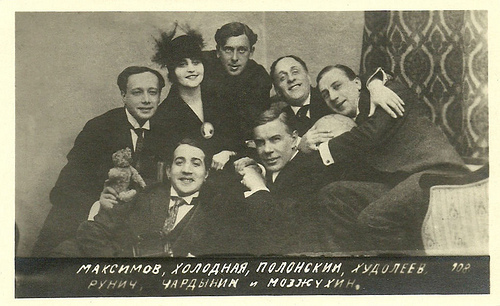
A Who is Who of the Russian silent cinema. In a circle from left: actor Vladimir Maksimov (with bear), actress Vera Kholodnaya , actor Vitold Polonsky, actor Ivan Khudoleyev, actor Ivan Mozzhukin , director Petr Cardynin and actor Ossip Runitsch . Russian postcard, no. 108. Collection: Didier Hanson.
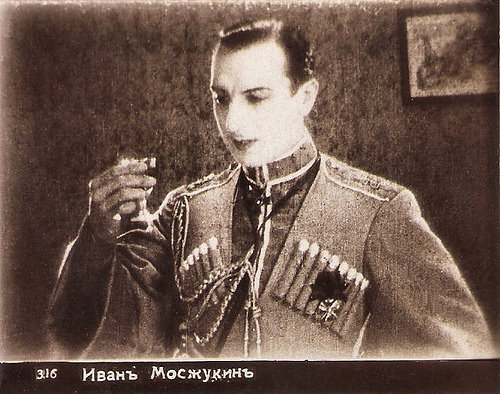
Ivan Mozzhukhin . Small Russian collectors card, no. 316.
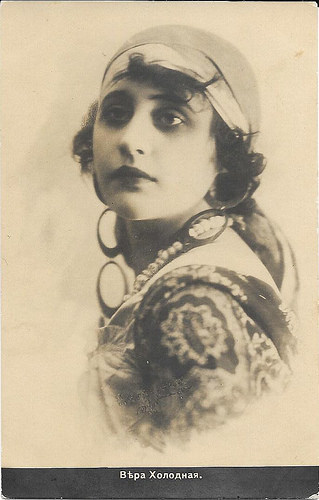
Vera Kholodnaya . Russian postcard. Collection: Didier Hanson.
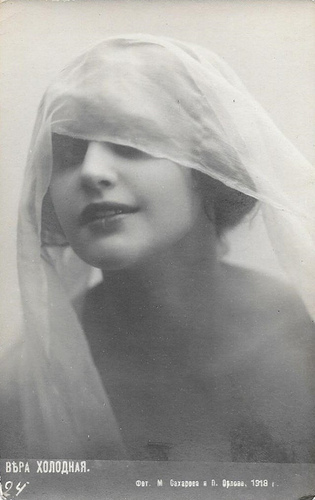
Vera Kholodnaya . Russian postcard, no. 24, 1918. Collection: Didier Hanson.
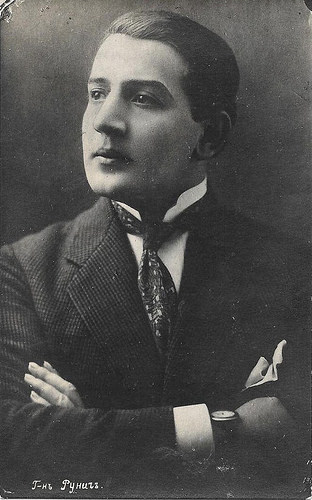
Ossip Runitsch . Russian postcard. Collection: Didier Hanson.
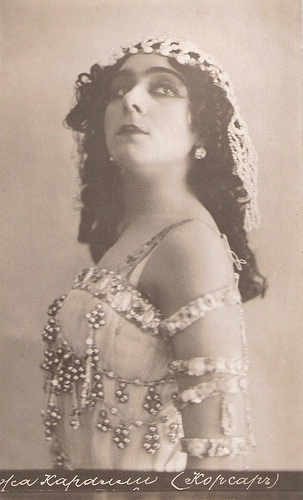
Vera Karalli . Vintage postcard.
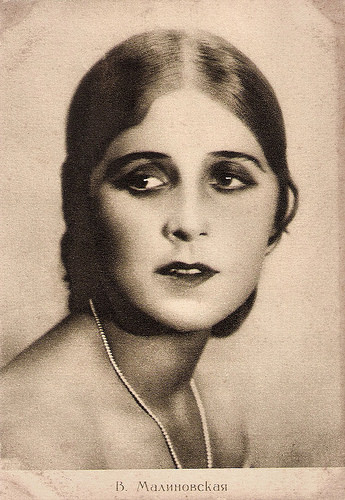
Vera Malinowskaja . Russian postcard by Roznak, Moscow, series no. 4, no. A 2400, 1927. Published in an edition of 25,000 cards.
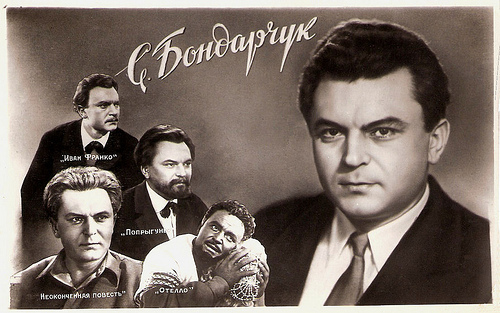
Sergei Bondarchuk . Soviet postcard by Molot, no. 34, 1959. This postcard was printed in an edition of 75.000 cards. Retail price: 75 K.
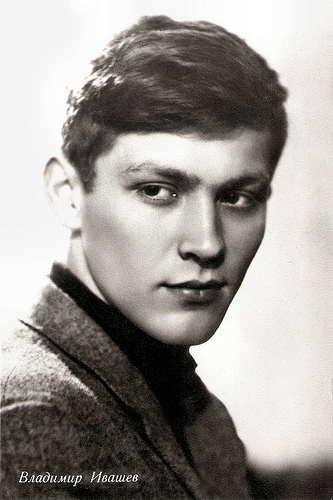
Vladimir Ivashov . Russian postcard by Izdanije Byuro Propogandy Sovietskogo Kinoiskusstva, no. M 78052, 1962. Retail price: 8 kop.
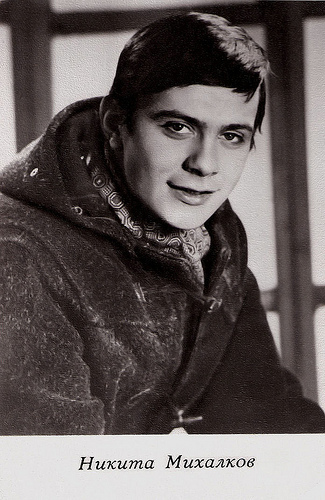
Nikita Mikhalkov . Russian postcard by Izdanije Byuro Propogandy Sovietskogo Kinoiskusstva, no. 4896, 1967. This postcard was printed in an edition of 100.000 cards. Retail price: 8 Kop.

Lyudmila Savelyeva . Russian postcard by Izdanije Byuro Propogandy Sovietskogo Kinoiskusstva, no. A 08351, 1969. This postcard was printed in an edition of 500,000 cards. Retail price was 6 kop. Photo: publicity still for Voyna i mir/War and Peace (Sergei Bondarchuk, 1965-1967).
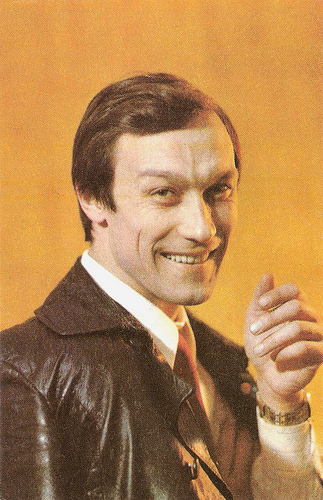
Oleg Yankovsky . Russian postcard by Izdanije Byuro Propogandy Sovietskogo Kinoiskusstva, nr. 2114221, 1977. This postcard was printed in an edition of 186.000 cards. The price was 6 kop.
Sources: BFI, Pordenone Silent Film Festival (Italian) and Wikipedia.

A Who is Who of the Russian silent cinema. In a circle from left: actor Vladimir Maksimov (with bear), actress Vera Kholodnaya , actor Vitold Polonsky, actor Ivan Khudoleyev, actor Ivan Mozzhukin , director Petr Cardynin and actor Ossip Runitsch . Russian postcard, no. 108. Collection: Didier Hanson.

Ivan Mozzhukhin . Small Russian collectors card, no. 316.

Vera Kholodnaya . Russian postcard. Collection: Didier Hanson.

Vera Kholodnaya . Russian postcard, no. 24, 1918. Collection: Didier Hanson.

Ossip Runitsch . Russian postcard. Collection: Didier Hanson.

Vera Karalli . Vintage postcard.

Vera Malinowskaja . Russian postcard by Roznak, Moscow, series no. 4, no. A 2400, 1927. Published in an edition of 25,000 cards.

Sergei Bondarchuk . Soviet postcard by Molot, no. 34, 1959. This postcard was printed in an edition of 75.000 cards. Retail price: 75 K.

Vladimir Ivashov . Russian postcard by Izdanije Byuro Propogandy Sovietskogo Kinoiskusstva, no. M 78052, 1962. Retail price: 8 kop.

Nikita Mikhalkov . Russian postcard by Izdanije Byuro Propogandy Sovietskogo Kinoiskusstva, no. 4896, 1967. This postcard was printed in an edition of 100.000 cards. Retail price: 8 Kop.

Lyudmila Savelyeva . Russian postcard by Izdanije Byuro Propogandy Sovietskogo Kinoiskusstva, no. A 08351, 1969. This postcard was printed in an edition of 500,000 cards. Retail price was 6 kop. Photo: publicity still for Voyna i mir/War and Peace (Sergei Bondarchuk, 1965-1967).

Oleg Yankovsky . Russian postcard by Izdanije Byuro Propogandy Sovietskogo Kinoiskusstva, nr. 2114221, 1977. This postcard was printed in an edition of 186.000 cards. The price was 6 kop.
Sources: BFI, Pordenone Silent Film Festival (Italian) and Wikipedia.
Published on November 08, 2014 22:00
Paul van Yperen's Blog
- Paul van Yperen's profile
- 13 followers
Paul van Yperen isn't a Goodreads Author
(yet),
but they
do have a blog,
so here are some recent posts imported from
their feed.



